Paul van Yperen's Blog, page 419
May 15, 2014
Dawn Addams
British actress Dawn Addams (1930-1985) launched her film career in Hollywood and later appeared in many European films of the 1950s and 1960s as an icy, unobtainable beauty. She worked with major directors like Otto Preminger, Charles Chaplin and Fritz Lang, but despite this she had a rather undistinguished film career, in which second-rate pictures outnumbered far the quality ones.
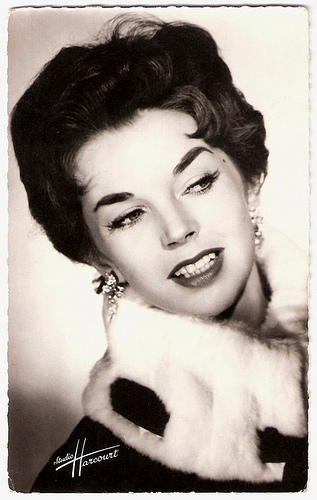
French postcard by Edition du Globe (E.D.U.G.), Paris, no. 693. Photo: Studio Harcourt.
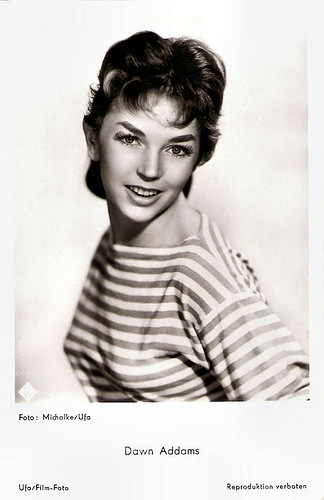
German postcard by Ufa, Berlin-Tempelhof, no. FK 3862. Photo: Georg Michalke / Ufa.
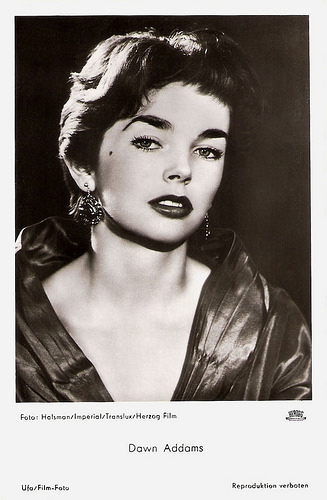
German postcard by Ufa, Berlin-Tempelhof, no. FK 2270. Photo: Halsman / Imperial-Translux / Herzog-Film.
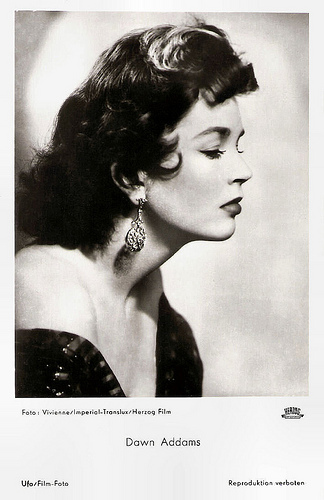
German postcard by Ufa, Berlin-Tempelhof, no. FK 2240. Photo: Vivienne / Imperial-Translux / Herzog-Film. Publicity still for Der Rommel-Schatz/Il tesoro di Rommel/Rommel's Treasure (Romolo Marcellini, 1955).
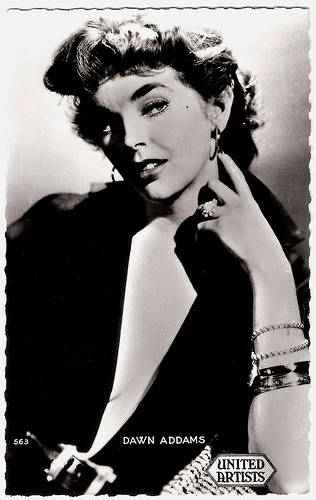
French postcard by Editions P.I., Paris, no. 563, offered by Les carbones Korès 'Carboplane'. Photo: United Artists. Publicity still for The Moon is Blue (Otto Preminger, 1953).
More Decorous Than Substantial
Victoria Dawn Addams was born in Felixstowe, England, in 1930. She was the daughter of Captain James Ramage Addams, a R.A.F. officer, and Ethel Mary Addams-Hickie. Her mother died when she was young, and Dawn spent her early life in Calcutta, India.
She studied acting in London and started her career working for a travelling theatre company. In 1949 she made her London debut in the farce Charley’s Aunt. Her beauty and physique soon attracted the attention of talent agents.
In 1950 she left for Hollywood to star in MGM movies. Her film debut was a supporting part in Night Into Morning (Fletcher Markle, 1951), an intimate drama about alcoholism starring Ray Milland .
She also appeared in the film noir The Unknown Man (Richard Thorpe, 1951) with Walter Pidgeon, the Victorian thriller The Hour of 13 (Harold French, 1952) opposite Peter Lawford, and Plymouth Adventure (Clarence Brown, 1952) with Spencer Tracy - the story of the Mayflower in its historic voyage across the Atlantic to the New World.
In 1952, Addams auditions for a role in Limelight ( Charlie Chaplin , 1953). Although she doesn’t get the part (it goes to Claire Bloom ), she becomes friends with Charlie and Oona Chaplin
Her roles were more decorous than substantial. Probably her best Hollywood film was the risqué (for its time) comedy The Moon Is Blue (Otto Preminger, 1953) starring William Holden, David Niven and Maggie McNamara. She also appeared in a supporting part in the German version, Die Jungfrau auf dem Dach (Otto Preminger, 1953), with Hardy Krüger , Johannes Heesters and Johanna Matz . She is the only player who appears in both versions because most of her dialog is on the telephone, thus it can easily be dubbed into German. The Moon is Blue helped to end the system of self-censorship of Hollywood films, which had been in place since 1934.
In 1953 Dawn also embarked on a USO tour to help entertain the troops in Korea, followed by a small but heavily publicized role as Richard Carlson's model girlfriend in the Sci-Fi film Riders to the Stars (Richard Carlson, 1954).
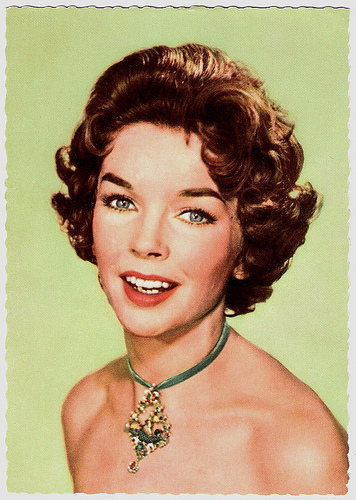
German postcard by Ufa, Berlin-Tempelhof, no. CK 173. Photo: Fried Agency / Ufa.
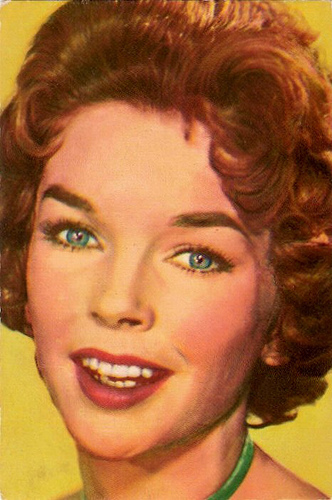
Belgian collector's card, no. 68.
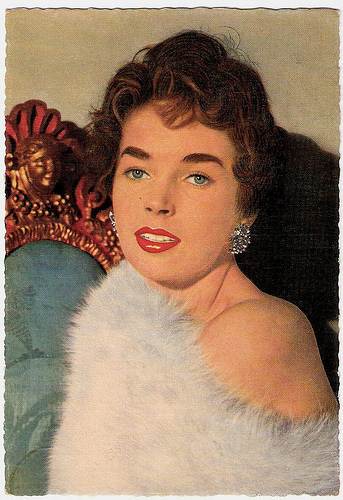
German postcard by WS-Druck, Wanne-Eickel, no. F 25. Photo: Klaus Collignon.
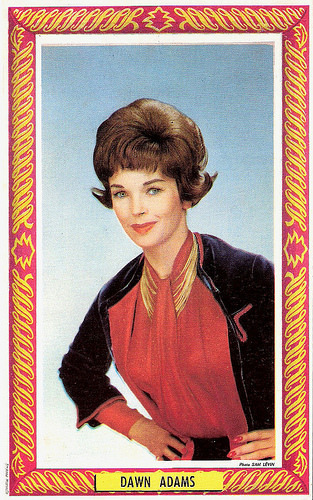
French postcard by St. Anne, Marseille. Photo: Sam Lévin.
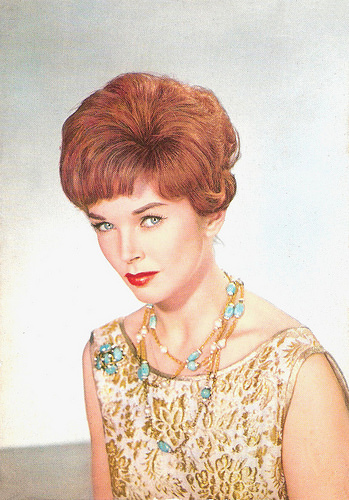
French postcard by Editions P.I., no. 1068. Photo: Sam Lévin.
Was Her Beauty Too Smooth?
Dawn Addams returned to Europe to continue her film career. In Italy she starred in the sensational war film Mizar/Frogwoman (Francesco De Robertis, 1954). Thanks to her lofty family lineage, she moved in the best social circles. During the production of Mizar she met the Prince of Roccasecca de Volsci, Don Vittorio Massimo, and married him. They settle at his castle in Scorona, 20 miles outside Rome.
In the following years she appeared in several second-rate pictures but also played in a few quality films including Charles Chaplin 's bitter comedy A King In New York (1956), "wherein Dawn had her best role as an American commercial actress", according to Hal Erickson at AllMovie .
She played opposite Laurence Harvey in the war film The Silent Enemy (William Fairchild, 1958), and opposite Brigitte Bardot in Voulez-vous danser avec moi?/Come Dance with Me! (Michel Boisrond, 1959).
The following year she starred in the thriller Die 1000 Augen des Dr. Mabuse/The Thousand Eyes of Dr. Mabuse (1960), the last film of director Fritz Lang.
Despite this she had an undistinguished film career, in which second-rate pictures far outnumbered the quality ones. “Was her beauty too smooth or were her acting talents limited or both?”, asks reviewer Guy Bellinger on IMDb .
In the early 1960s Dawn appeared in a some more good films, including The Two Faces of Dr. Jekyll (Terence Fisher, 1960) starring Paul Massie and Christopher Lee, the Gustave Flaubert adaptation L’éducation sentimentale/Sentimental Education (Alexandre Astruc, 1962) with Jean-Claude Brialy , the swashbuckler La tulipe noire/The Black Tulip (Christian-Jaque, 1964) starring Alain Delon , and the swinging-sixties-London-cheesecake Ballad in Blue (1964, Paul Henreid), top-billing soul singer Ray Charles as himself.
From then on she mostly appeared on television, for example in series like Danger Man (1964), The Saint (1963-1966) - which starred Roger Moore as Simon Templar, the sitcom Father Dear Father (1971-1973), the campy sci-fi serial Star Maidens (1977), the soap opera Crossroads (1977), and finally Triangle (1983), a series about the crew and passengers of a North Sea ferry, on the triangular route between Felixstowe, Gothenburg and Amsterdam.
Her last feature film was the B-film The Vault of Horror (Roy Ward Baker, 1973).
She was married twice. From 1954 till 1971 she was married to Don Vittorio Emanuele Massimo. They had one son, Prince Stefano Massimo (1955). After their separation they had a much publicized feud about their son. In 1974 Addams married Jimmy White.
In 1985, Dawn Addams died from cancer in London.
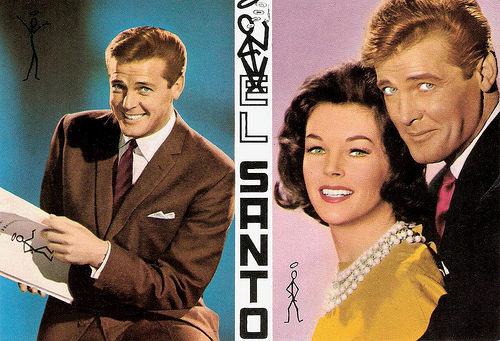
Spanish postcard by Postal Oscarcolor, no. 553. Publicity still for The Saint (1963-1966) with Roger Moore .
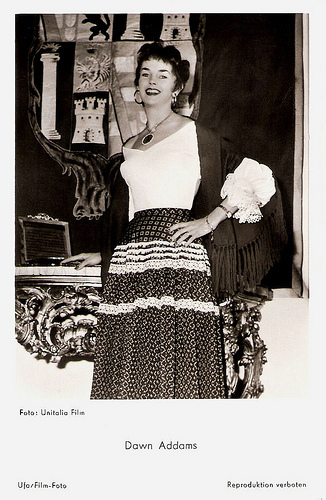
German postcard by Ufa, Berlin-Tempelhof, no. FK 3960. Retail price: 25 Pfg. Photo: Unitalia Film.
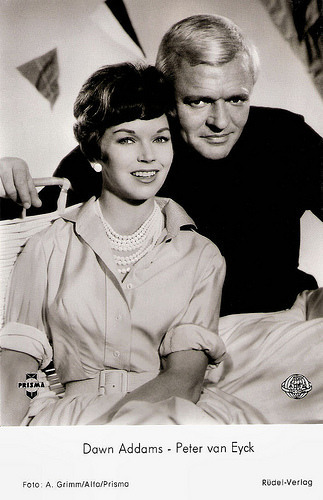
German postcard by Rüdel-Verlag, Hamburg-Bergedorf, no. 2852. Photo: Arthur Grimm / Alfa / Prisma. Publicity still for Geheimaktion Schwarze Kapelle/The Black Chapel (Ralph Habib, 1959) with Peter van Eyck.
Trailer of Hot Money Girl (1959) with Eddie Constantine . Source: Ourmaninhavanna (YouTube).
Trailer of The Vampire Lovers (1970) with Ingrid Pitt and Peter Cushing. Source: Lv99Slacker (YouTube).
Sources: Collector’s card, Hal Erickson (AllMovie), (IMDb), Film Reference, Glamour Girls of the Silver Screen, Wikipedia, and .

French postcard by Edition du Globe (E.D.U.G.), Paris, no. 693. Photo: Studio Harcourt.

German postcard by Ufa, Berlin-Tempelhof, no. FK 3862. Photo: Georg Michalke / Ufa.

German postcard by Ufa, Berlin-Tempelhof, no. FK 2270. Photo: Halsman / Imperial-Translux / Herzog-Film.

German postcard by Ufa, Berlin-Tempelhof, no. FK 2240. Photo: Vivienne / Imperial-Translux / Herzog-Film. Publicity still for Der Rommel-Schatz/Il tesoro di Rommel/Rommel's Treasure (Romolo Marcellini, 1955).

French postcard by Editions P.I., Paris, no. 563, offered by Les carbones Korès 'Carboplane'. Photo: United Artists. Publicity still for The Moon is Blue (Otto Preminger, 1953).
More Decorous Than Substantial
Victoria Dawn Addams was born in Felixstowe, England, in 1930. She was the daughter of Captain James Ramage Addams, a R.A.F. officer, and Ethel Mary Addams-Hickie. Her mother died when she was young, and Dawn spent her early life in Calcutta, India.
She studied acting in London and started her career working for a travelling theatre company. In 1949 she made her London debut in the farce Charley’s Aunt. Her beauty and physique soon attracted the attention of talent agents.
In 1950 she left for Hollywood to star in MGM movies. Her film debut was a supporting part in Night Into Morning (Fletcher Markle, 1951), an intimate drama about alcoholism starring Ray Milland .
She also appeared in the film noir The Unknown Man (Richard Thorpe, 1951) with Walter Pidgeon, the Victorian thriller The Hour of 13 (Harold French, 1952) opposite Peter Lawford, and Plymouth Adventure (Clarence Brown, 1952) with Spencer Tracy - the story of the Mayflower in its historic voyage across the Atlantic to the New World.
In 1952, Addams auditions for a role in Limelight ( Charlie Chaplin , 1953). Although she doesn’t get the part (it goes to Claire Bloom ), she becomes friends with Charlie and Oona Chaplin
Her roles were more decorous than substantial. Probably her best Hollywood film was the risqué (for its time) comedy The Moon Is Blue (Otto Preminger, 1953) starring William Holden, David Niven and Maggie McNamara. She also appeared in a supporting part in the German version, Die Jungfrau auf dem Dach (Otto Preminger, 1953), with Hardy Krüger , Johannes Heesters and Johanna Matz . She is the only player who appears in both versions because most of her dialog is on the telephone, thus it can easily be dubbed into German. The Moon is Blue helped to end the system of self-censorship of Hollywood films, which had been in place since 1934.
In 1953 Dawn also embarked on a USO tour to help entertain the troops in Korea, followed by a small but heavily publicized role as Richard Carlson's model girlfriend in the Sci-Fi film Riders to the Stars (Richard Carlson, 1954).

German postcard by Ufa, Berlin-Tempelhof, no. CK 173. Photo: Fried Agency / Ufa.

Belgian collector's card, no. 68.

German postcard by WS-Druck, Wanne-Eickel, no. F 25. Photo: Klaus Collignon.

French postcard by St. Anne, Marseille. Photo: Sam Lévin.

French postcard by Editions P.I., no. 1068. Photo: Sam Lévin.
Was Her Beauty Too Smooth?
Dawn Addams returned to Europe to continue her film career. In Italy she starred in the sensational war film Mizar/Frogwoman (Francesco De Robertis, 1954). Thanks to her lofty family lineage, she moved in the best social circles. During the production of Mizar she met the Prince of Roccasecca de Volsci, Don Vittorio Massimo, and married him. They settle at his castle in Scorona, 20 miles outside Rome.
In the following years she appeared in several second-rate pictures but also played in a few quality films including Charles Chaplin 's bitter comedy A King In New York (1956), "wherein Dawn had her best role as an American commercial actress", according to Hal Erickson at AllMovie .
She played opposite Laurence Harvey in the war film The Silent Enemy (William Fairchild, 1958), and opposite Brigitte Bardot in Voulez-vous danser avec moi?/Come Dance with Me! (Michel Boisrond, 1959).
The following year she starred in the thriller Die 1000 Augen des Dr. Mabuse/The Thousand Eyes of Dr. Mabuse (1960), the last film of director Fritz Lang.
Despite this she had an undistinguished film career, in which second-rate pictures far outnumbered the quality ones. “Was her beauty too smooth or were her acting talents limited or both?”, asks reviewer Guy Bellinger on IMDb .
In the early 1960s Dawn appeared in a some more good films, including The Two Faces of Dr. Jekyll (Terence Fisher, 1960) starring Paul Massie and Christopher Lee, the Gustave Flaubert adaptation L’éducation sentimentale/Sentimental Education (Alexandre Astruc, 1962) with Jean-Claude Brialy , the swashbuckler La tulipe noire/The Black Tulip (Christian-Jaque, 1964) starring Alain Delon , and the swinging-sixties-London-cheesecake Ballad in Blue (1964, Paul Henreid), top-billing soul singer Ray Charles as himself.
From then on she mostly appeared on television, for example in series like Danger Man (1964), The Saint (1963-1966) - which starred Roger Moore as Simon Templar, the sitcom Father Dear Father (1971-1973), the campy sci-fi serial Star Maidens (1977), the soap opera Crossroads (1977), and finally Triangle (1983), a series about the crew and passengers of a North Sea ferry, on the triangular route between Felixstowe, Gothenburg and Amsterdam.
Her last feature film was the B-film The Vault of Horror (Roy Ward Baker, 1973).
She was married twice. From 1954 till 1971 she was married to Don Vittorio Emanuele Massimo. They had one son, Prince Stefano Massimo (1955). After their separation they had a much publicized feud about their son. In 1974 Addams married Jimmy White.
In 1985, Dawn Addams died from cancer in London.

Spanish postcard by Postal Oscarcolor, no. 553. Publicity still for The Saint (1963-1966) with Roger Moore .

German postcard by Ufa, Berlin-Tempelhof, no. FK 3960. Retail price: 25 Pfg. Photo: Unitalia Film.

German postcard by Rüdel-Verlag, Hamburg-Bergedorf, no. 2852. Photo: Arthur Grimm / Alfa / Prisma. Publicity still for Geheimaktion Schwarze Kapelle/The Black Chapel (Ralph Habib, 1959) with Peter van Eyck.
Trailer of Hot Money Girl (1959) with Eddie Constantine . Source: Ourmaninhavanna (YouTube).
Trailer of The Vampire Lovers (1970) with Ingrid Pitt and Peter Cushing. Source: Lv99Slacker (YouTube).
Sources: Collector’s card, Hal Erickson (AllMovie), (IMDb), Film Reference, Glamour Girls of the Silver Screen, Wikipedia, and .
Published on May 15, 2014 23:00
May 14, 2014
Susi Nicoletti
Bavarian-born actress Susi Nicoletti (1918–2005) was an eminent stage actress of the Burgtheater in Vienna. Today she is best remembered for her supporting roles in dozens of German film comedies of the 1940s and 1950s.
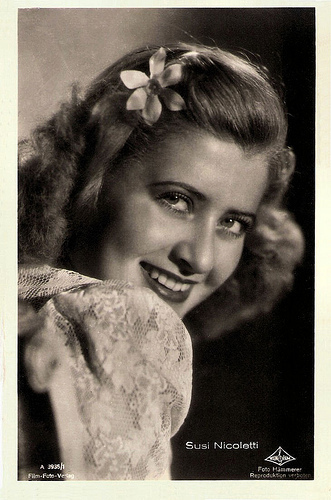
German postcard by Film-Foto-Verlag, no. A 3935/1. Photo: Wien Film / Hämmerer.
Burgtheater
Susi Nicoletti was born as Susanne Emilie Luise Adele Habersack in Munich in 1918. Her parents were actress Consuella Nicoletti, and Ernst Habersack, boss of a shipping company. From 1921 to 1927, she lived with her parents in Amsterdam, The Netherlands.
Back in Munich, she made her stage debut at age 13 at the Kammerspiele in Munich and became solo dancer for the Munich Opera two years later. Around that time she joined the cabaret Die weißblaue Drehorgel. She also got acting training by Magda Lina.
Between 1936 and 1940, she was engaged by the Nürnberg city theatre. In 1939, she was offered her first film role in the short Schwarz und Blond/Black and Blond (Philipp von Zeska, 1939) with O.W. Fischer .
It was followed by a role in Mutterliebe/Mother Love (Gustav Ucicky, 1939).
In 1940 she moved to Vienna, where she became an ensemble member of the Burgtheater. She continued to appear in such German films as the comedy Oh, diese Männer/Oh, Those Men (Hubert Marischka, 1941) as the daughter of Georg Alexander and Grethe Weiser, the romantic drama Sommerliebe/Summer Love (1942) starring Winnie Markus , and Der zweite Schuß/The second shot (Martin Fric, 1943), in which she played the female lead.
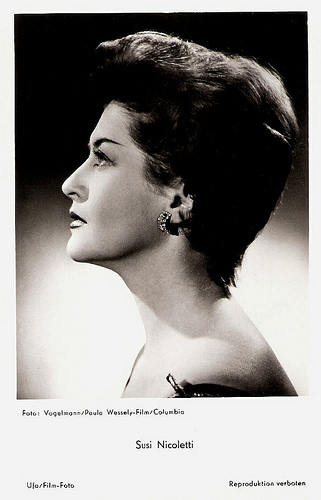
German postcard by Ufa, Berlin-Tempelhof, no. FK 3001. Photo: Vogelmann / Paula Wessely-Film / Columbia.
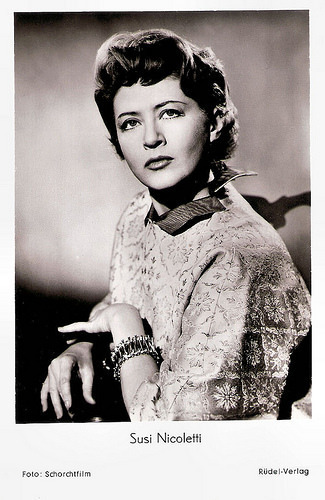
German postcard by Rüdel-Verlag, Hamburg-Bergedorf, no. 2025. Photo: Schorchtfilm. Publicity still for Die Liebe Familie/Dear Family (Helmut Weiss, 1957).
Comedian Harmonists
After the war, Susi Nicoletti continued her stage and film career. In 1946 she also began to perform at the Salzburg Festival.
Among the first post-war films were Das singende Haus/The Singing House (Franz Antel, 1947) and Philine ( Theo Lingen , 1949).
She often played in comedies, such as Es schlägt 13/It strikes 13 (E.W. Emo, 1951) with Theo Lingen, Hallo Dienstmann/Hello Porter (Franz Antel, 1952) with Hans Moser and Paul Hörbiger , Mariandl (Werner Jacobs, 1961) with Conny Froboess , and the TV film Mein Freund Harvey/My Friend Harvey (Kurt Wilhelm, 1970) opposite Heinz Rühmann .
One of her best films was the Thomas Mann adaptation Bekenntnisse des Hochstaplers Felix Krull/Confessions of Felix Krull (Kurt Hoffmann, 1957) starring Horst Buchholz .
From the mid-1950s on, Susi Nicoletti taught acting and dance at the prestigious Max Reinhardt Seminar in Vienna. Among her students were Senta Berger , Erika Pluhar, Ute Lemper, Heidelinde Weis, Pia Douwes and Albert Fortell.
After her retirement at the Burgtheater in 1992 she continued her stage career at the Theater in der Josefstadt.
In the late 1990s she stopped teaching at the Max Reinhardt seminar. Her final films were Comedian Harmonists (Joseph Vilsmaier, 1997), the story of the famous, Weimar male sextet, and Am anderen Ende der Brücke/On the Other Side of the Bridge (Mei Hu, 2002) starring Nina Proll.
In 2005, Susi Nicoletti died in Vienna of complications after heart surgery, aged 86.
She was twice married. Her first husband was film businessman Ludwig Ptack. Her second husband, Ernst Häussermann, who had passed away in 1984, was an actor and director of the Burgtheater and the Theater in der Josefstadt. Their son, daughter and grandchildren live in the United States.
In 1977 she was awarded with the Austrian Cross of Honour for Science and Art, 1st class.
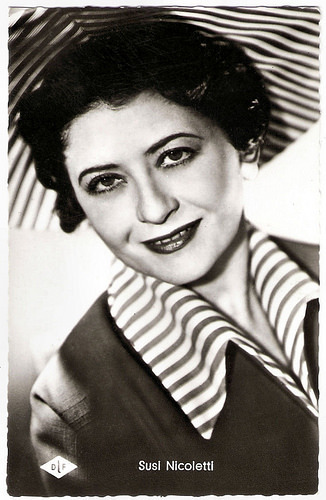
German postcard by Kolibri-Verlag, Minden / Westf., no. 1989. Photo: Wien-Film / Deutsche London.Publicity still for Sonnenschein und Wollkenbruch/Sunshine and cloudburst (Rudolf Nussgruber, 1955).
Sources: Wikipedia and .

German postcard by Film-Foto-Verlag, no. A 3935/1. Photo: Wien Film / Hämmerer.
Burgtheater
Susi Nicoletti was born as Susanne Emilie Luise Adele Habersack in Munich in 1918. Her parents were actress Consuella Nicoletti, and Ernst Habersack, boss of a shipping company. From 1921 to 1927, she lived with her parents in Amsterdam, The Netherlands.
Back in Munich, she made her stage debut at age 13 at the Kammerspiele in Munich and became solo dancer for the Munich Opera two years later. Around that time she joined the cabaret Die weißblaue Drehorgel. She also got acting training by Magda Lina.
Between 1936 and 1940, she was engaged by the Nürnberg city theatre. In 1939, she was offered her first film role in the short Schwarz und Blond/Black and Blond (Philipp von Zeska, 1939) with O.W. Fischer .
It was followed by a role in Mutterliebe/Mother Love (Gustav Ucicky, 1939).
In 1940 she moved to Vienna, where she became an ensemble member of the Burgtheater. She continued to appear in such German films as the comedy Oh, diese Männer/Oh, Those Men (Hubert Marischka, 1941) as the daughter of Georg Alexander and Grethe Weiser, the romantic drama Sommerliebe/Summer Love (1942) starring Winnie Markus , and Der zweite Schuß/The second shot (Martin Fric, 1943), in which she played the female lead.

German postcard by Ufa, Berlin-Tempelhof, no. FK 3001. Photo: Vogelmann / Paula Wessely-Film / Columbia.

German postcard by Rüdel-Verlag, Hamburg-Bergedorf, no. 2025. Photo: Schorchtfilm. Publicity still for Die Liebe Familie/Dear Family (Helmut Weiss, 1957).
Comedian Harmonists
After the war, Susi Nicoletti continued her stage and film career. In 1946 she also began to perform at the Salzburg Festival.
Among the first post-war films were Das singende Haus/The Singing House (Franz Antel, 1947) and Philine ( Theo Lingen , 1949).
She often played in comedies, such as Es schlägt 13/It strikes 13 (E.W. Emo, 1951) with Theo Lingen, Hallo Dienstmann/Hello Porter (Franz Antel, 1952) with Hans Moser and Paul Hörbiger , Mariandl (Werner Jacobs, 1961) with Conny Froboess , and the TV film Mein Freund Harvey/My Friend Harvey (Kurt Wilhelm, 1970) opposite Heinz Rühmann .
One of her best films was the Thomas Mann adaptation Bekenntnisse des Hochstaplers Felix Krull/Confessions of Felix Krull (Kurt Hoffmann, 1957) starring Horst Buchholz .
From the mid-1950s on, Susi Nicoletti taught acting and dance at the prestigious Max Reinhardt Seminar in Vienna. Among her students were Senta Berger , Erika Pluhar, Ute Lemper, Heidelinde Weis, Pia Douwes and Albert Fortell.
After her retirement at the Burgtheater in 1992 she continued her stage career at the Theater in der Josefstadt.
In the late 1990s she stopped teaching at the Max Reinhardt seminar. Her final films were Comedian Harmonists (Joseph Vilsmaier, 1997), the story of the famous, Weimar male sextet, and Am anderen Ende der Brücke/On the Other Side of the Bridge (Mei Hu, 2002) starring Nina Proll.
In 2005, Susi Nicoletti died in Vienna of complications after heart surgery, aged 86.
She was twice married. Her first husband was film businessman Ludwig Ptack. Her second husband, Ernst Häussermann, who had passed away in 1984, was an actor and director of the Burgtheater and the Theater in der Josefstadt. Their son, daughter and grandchildren live in the United States.
In 1977 she was awarded with the Austrian Cross of Honour for Science and Art, 1st class.

German postcard by Kolibri-Verlag, Minden / Westf., no. 1989. Photo: Wien-Film / Deutsche London.Publicity still for Sonnenschein und Wollkenbruch/Sunshine and cloudburst (Rudolf Nussgruber, 1955).
Sources: Wikipedia and .
Published on May 14, 2014 23:00
May 13, 2014
Marie Laforêt
Marie Laforêt (1939)is a French singer and actress of Armenian descent. After her first film appearance in the drama Plein Soleil (1960) opposite Alain Delon she became very popular and interpreted many roles in the 1960s. As a singer she is best loved for Marie douceur, Marie colère, her version of the Rolling Stones hit Paint it black.
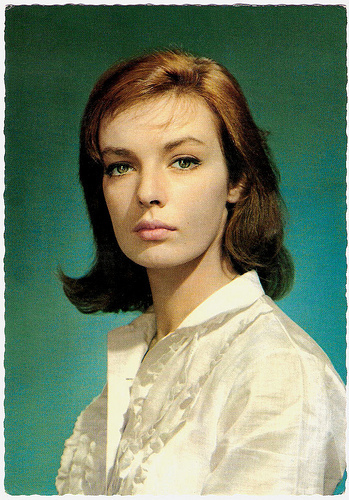
French postcard by E.D.U.G., no. 69.
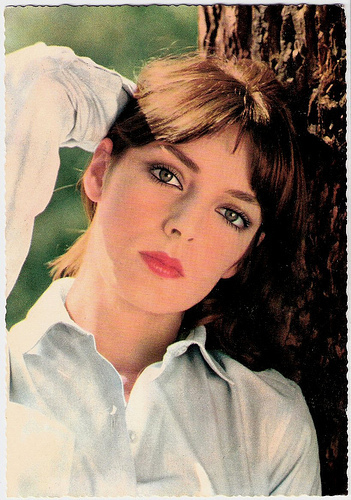
German postcard by Krüger, no. 902/344. Photo: Gérard Decaux.
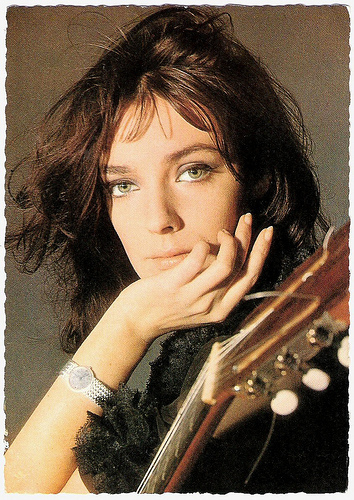
French postcard by PSG, no. 931. Photo: P. de Mervellec.
The Girl with the Golden Eyes
Marie Laforêt was born as Maïténa Doumenach in Soulac-sur-Mer in the Gironde in 1939. Her parents were of Armenian origin.
Marie’s career began accidentally in 1959 when she stepped in for her sister at the last minute in the French radio talent contest Naissance d'une étoile (Birth of a star) - and won.
Director Louis Malle then cast her in the film he was shooting at the time, Liberté (Freedom). The film was eventually abandoned but Marie went on to take the lead female role opposite heart throb Alain Delon in the classic Plein Soleil/Purple Noon (René Clément, 1960), based on the novel The talented Mr Ripley by Patricia Highsmith.
That same year she married director Jean-Gabriel Albicocco, who cast her later in some of his own works, including La Fille aux Yeux d'Or/The Girl with the Golden Eyes (1961), based on the Honoré de Balzac story. The film title would become her nickname.
In her second film, Saint Tropez Blues (Marcel Moussy, 1961), accompanied by a young Jacques Higelin at the guitar, she sang the title song. Immediately she started releasing singles.
Her first hit was the chirpy folkish Les Vendanges de l'Amour in 1963. In a translated version, the song also gave Marie a top ten hit in Italy, as La vendemmia dell'amore, a year later.
She also recorded some rock songs, her most famous being Marie-douceur, Marie-colère (1966), a cracking version of the Rolling Stones hit Paint It Black.
Another popular recording was 1965s girl-groupish A demain, my darling, known by English-speakers as The Sha La La Song and recorded by Marianne Faithfull on her debut album.
Her later songs offered a more mature, poetic, tender alternative to the light, teenage yé-yé tunes charting in France at the time. Her melodies borrowed more from exotic folk music, especially South American and Eastern European, than from contemporary American and British pop acts.
Laforêt worked with many important French composers, musicians and lyricists, such as André Popp and Pierre Cour, who provided her with a panoply of colourful, sophisticated orchestral arrangements, featuring dozens of musical instruments and creating a variety of sounds, sometimes almost Medieval, Renaissance or Baroque, other times quite modern and innovative.
Meanwhile she appeared in several French and Italian films, including Leviathan/Dark Journey (Léonard Keigel, 1962) with Louis Jourdan , À cause, à cause d'une femme/Because, Because of a Woman (Michel Deville, 1963) with Jacques Charrier , La chasse à l'homme/Male Hunt (Edouard Molinaro, 1964) opposite Jean-Paul Belmondo , and Le soldatesse/The Camp Followers (Valerio Zurlini, 1965) starring Anna Karina .
She also appeared opposite George Hamilton in the American comedy Jack of Diamonds (Don Sharp, 1967).
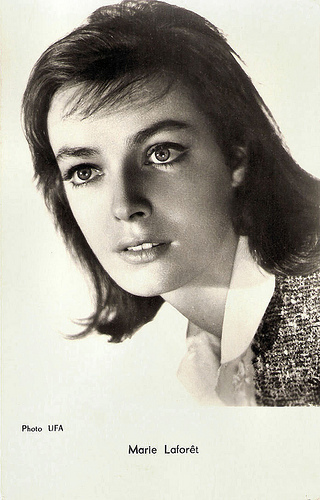
French postcard by Editions P.I., Paris, no. FK 125. Photo: Ufa.
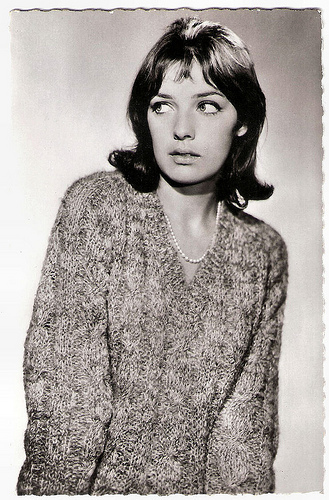
French postcard by Editions du Globe, Paris, no. 871. Photo: Studio Vauclair, Paris.
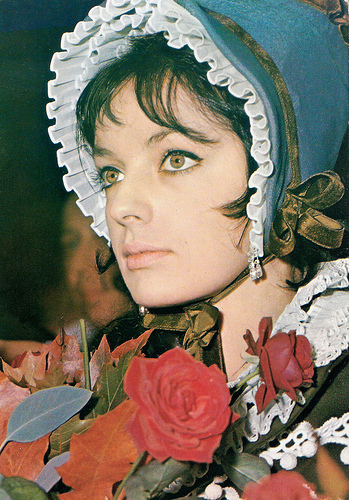
Belgian postcard by Editions Decker, Brussels, no. A 110.
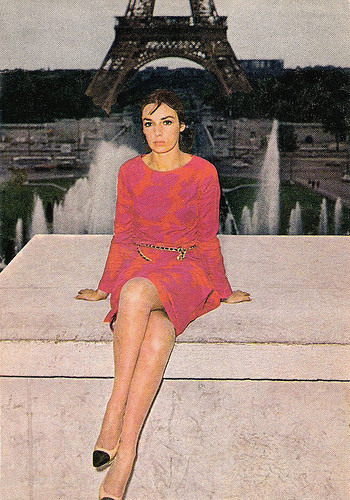
Italian postcard by Diesse / Cristo San Pietro in Corte, Monticello.
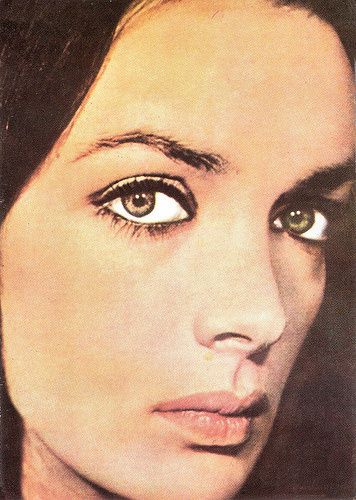
Romanian postcard by Casa Filmului Acin.
The Exile of Carlos Gardel
At the end of the 1960s, Marie Laforêt had become a rather distinctive figure in the French pop scene. Her music stood out, perhaps too much for her new label CBS Records, which expected of her more upbeat, simpler songs. Marie fell out with the record company’s bosses over her choice of material, which they felt not to be sufficiently commercial. She was interested in making more personal records, but finally gave in.
Although her most financially successful singles (Viens, Viens, a 1973 cover of a British hit, and Il a neigé sur Yesterday (1977), a ballad written by Michel Jourdan about the break-up of the Beatles ) were released in the 1970s, Marie progressively lost interest in her singing career.
She moved to Geneva, Switzerland in 1978, where she opened an art gallery and abandoned music more or less altogether. She incidentally appeared in films, including the fairy-tale adaptation Le petit poucet/Tom Thumb (Michel Deville, 1972) and the action comedy Flic ou voyou/Cop or Hood (Georges Lautner, 1979) featuring Jean-Paul Belmondo .
In the 1980s, she concentrated on her acting career, appearing in such French and Italian films as the comedy Les diplômés du dernier rang (Christian Gion, 1982) with Michel Galabru, another Belmondo actioner Les morfalous (Henri Verneuil, 1984) and the little seen masterpiece Tangos, l'exil de Gardel/Tangos, the Exile of Gardel (Fernando E. Solanas, 1985) dedicated to Carlos Gardel, the legendary Argentinian tango star.
She also played regularly on TV as in the popular mini-series La piovra 3/The Octopus 3 (Luigi Perelli, 1987) starring Michele Placido.
Laforêt eventually released some music singles, but they were not popular. She made a comeback, however, in 1993 with an album (her last) for which she wrote the lyrics.
In the 1990s, she again continued to work as an actress, both on stage and on screen in such films as the romance Dis-moi oui.../Say Yes To Me (Alexandre Arcady, 1995) with Jean-Hugues Anglade , and the Sci-Fi film Tykho Moon (Enki Bilal, 1996) with Julie Delpy.
She has performed in a number of plays in Paris over the years, acclaimed by audiences and critics alike. In September 2005 she sang once again, going on tour in France for the first time since 1972. Every concert was sold out.
Her most recent film is the comedy-drama Les bureaux de Dieu/God’s Offices (Claire Simon, 2008) about dedicated social workers who devote their long shifts to helping pregnant women.
Marie Laforêt still resides in Geneva and has obtained Swiss citizenship. She is the mother of writer-director Liza Azuelos, with whom she worked on the film Ainsi soient-elles/That’s How Women Are (Liza Azuelos, Patrick Alessandrin, 1995) with Vincent Cassel and Thomas Kretschmann.
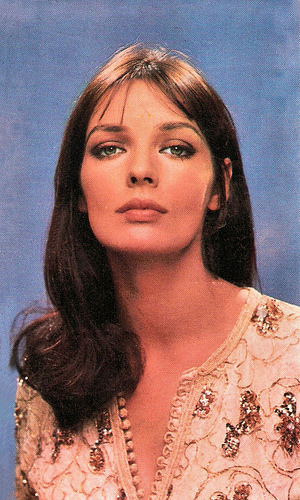
French postcard by PSG, presented by Corvisart, Epinal, no. 474. Photo: Sam Lévin.
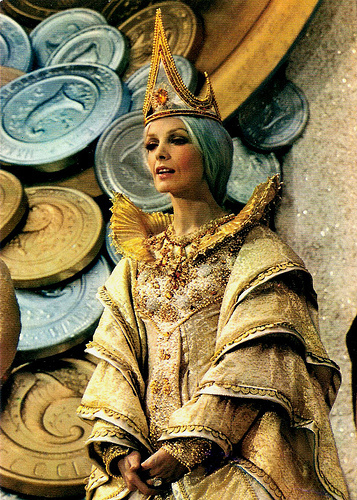
French postcard by Librairie Hachette, Paris, no. 2. Photo: Parc Film Navarre & associes. Publicity still for Le Petit Poucet/Tom Thumb (Michel Boisrond, 1972).
Marie Laforet sings Ivan, Boris & Moi on French TV in the Sacha show (1968) with among the dancers Sacha Distel and Jean Yanne. Source: cyclopede (YouTube).
Marie Laforêt sings Viens viens, Source: mauricizf (YouTube).
Marie Laforet sings je voudrais tant que tu comprennes in Surprise Partie (1997).
Sources: Ready Steady Girls, Wikipedia and .

French postcard by E.D.U.G., no. 69.

German postcard by Krüger, no. 902/344. Photo: Gérard Decaux.

French postcard by PSG, no. 931. Photo: P. de Mervellec.
The Girl with the Golden Eyes
Marie Laforêt was born as Maïténa Doumenach in Soulac-sur-Mer in the Gironde in 1939. Her parents were of Armenian origin.
Marie’s career began accidentally in 1959 when she stepped in for her sister at the last minute in the French radio talent contest Naissance d'une étoile (Birth of a star) - and won.
Director Louis Malle then cast her in the film he was shooting at the time, Liberté (Freedom). The film was eventually abandoned but Marie went on to take the lead female role opposite heart throb Alain Delon in the classic Plein Soleil/Purple Noon (René Clément, 1960), based on the novel The talented Mr Ripley by Patricia Highsmith.
That same year she married director Jean-Gabriel Albicocco, who cast her later in some of his own works, including La Fille aux Yeux d'Or/The Girl with the Golden Eyes (1961), based on the Honoré de Balzac story. The film title would become her nickname.
In her second film, Saint Tropez Blues (Marcel Moussy, 1961), accompanied by a young Jacques Higelin at the guitar, she sang the title song. Immediately she started releasing singles.
Her first hit was the chirpy folkish Les Vendanges de l'Amour in 1963. In a translated version, the song also gave Marie a top ten hit in Italy, as La vendemmia dell'amore, a year later.
She also recorded some rock songs, her most famous being Marie-douceur, Marie-colère (1966), a cracking version of the Rolling Stones hit Paint It Black.
Another popular recording was 1965s girl-groupish A demain, my darling, known by English-speakers as The Sha La La Song and recorded by Marianne Faithfull on her debut album.
Her later songs offered a more mature, poetic, tender alternative to the light, teenage yé-yé tunes charting in France at the time. Her melodies borrowed more from exotic folk music, especially South American and Eastern European, than from contemporary American and British pop acts.
Laforêt worked with many important French composers, musicians and lyricists, such as André Popp and Pierre Cour, who provided her with a panoply of colourful, sophisticated orchestral arrangements, featuring dozens of musical instruments and creating a variety of sounds, sometimes almost Medieval, Renaissance or Baroque, other times quite modern and innovative.
Meanwhile she appeared in several French and Italian films, including Leviathan/Dark Journey (Léonard Keigel, 1962) with Louis Jourdan , À cause, à cause d'une femme/Because, Because of a Woman (Michel Deville, 1963) with Jacques Charrier , La chasse à l'homme/Male Hunt (Edouard Molinaro, 1964) opposite Jean-Paul Belmondo , and Le soldatesse/The Camp Followers (Valerio Zurlini, 1965) starring Anna Karina .
She also appeared opposite George Hamilton in the American comedy Jack of Diamonds (Don Sharp, 1967).

French postcard by Editions P.I., Paris, no. FK 125. Photo: Ufa.

French postcard by Editions du Globe, Paris, no. 871. Photo: Studio Vauclair, Paris.

Belgian postcard by Editions Decker, Brussels, no. A 110.

Italian postcard by Diesse / Cristo San Pietro in Corte, Monticello.

Romanian postcard by Casa Filmului Acin.
The Exile of Carlos Gardel
At the end of the 1960s, Marie Laforêt had become a rather distinctive figure in the French pop scene. Her music stood out, perhaps too much for her new label CBS Records, which expected of her more upbeat, simpler songs. Marie fell out with the record company’s bosses over her choice of material, which they felt not to be sufficiently commercial. She was interested in making more personal records, but finally gave in.
Although her most financially successful singles (Viens, Viens, a 1973 cover of a British hit, and Il a neigé sur Yesterday (1977), a ballad written by Michel Jourdan about the break-up of the Beatles ) were released in the 1970s, Marie progressively lost interest in her singing career.
She moved to Geneva, Switzerland in 1978, where she opened an art gallery and abandoned music more or less altogether. She incidentally appeared in films, including the fairy-tale adaptation Le petit poucet/Tom Thumb (Michel Deville, 1972) and the action comedy Flic ou voyou/Cop or Hood (Georges Lautner, 1979) featuring Jean-Paul Belmondo .
In the 1980s, she concentrated on her acting career, appearing in such French and Italian films as the comedy Les diplômés du dernier rang (Christian Gion, 1982) with Michel Galabru, another Belmondo actioner Les morfalous (Henri Verneuil, 1984) and the little seen masterpiece Tangos, l'exil de Gardel/Tangos, the Exile of Gardel (Fernando E. Solanas, 1985) dedicated to Carlos Gardel, the legendary Argentinian tango star.
She also played regularly on TV as in the popular mini-series La piovra 3/The Octopus 3 (Luigi Perelli, 1987) starring Michele Placido.
Laforêt eventually released some music singles, but they were not popular. She made a comeback, however, in 1993 with an album (her last) for which she wrote the lyrics.
In the 1990s, she again continued to work as an actress, both on stage and on screen in such films as the romance Dis-moi oui.../Say Yes To Me (Alexandre Arcady, 1995) with Jean-Hugues Anglade , and the Sci-Fi film Tykho Moon (Enki Bilal, 1996) with Julie Delpy.
She has performed in a number of plays in Paris over the years, acclaimed by audiences and critics alike. In September 2005 she sang once again, going on tour in France for the first time since 1972. Every concert was sold out.
Her most recent film is the comedy-drama Les bureaux de Dieu/God’s Offices (Claire Simon, 2008) about dedicated social workers who devote their long shifts to helping pregnant women.
Marie Laforêt still resides in Geneva and has obtained Swiss citizenship. She is the mother of writer-director Liza Azuelos, with whom she worked on the film Ainsi soient-elles/That’s How Women Are (Liza Azuelos, Patrick Alessandrin, 1995) with Vincent Cassel and Thomas Kretschmann.

French postcard by PSG, presented by Corvisart, Epinal, no. 474. Photo: Sam Lévin.

French postcard by Librairie Hachette, Paris, no. 2. Photo: Parc Film Navarre & associes. Publicity still for Le Petit Poucet/Tom Thumb (Michel Boisrond, 1972).
Marie Laforet sings Ivan, Boris & Moi on French TV in the Sacha show (1968) with among the dancers Sacha Distel and Jean Yanne. Source: cyclopede (YouTube).
Marie Laforêt sings Viens viens, Source: mauricizf (YouTube).
Marie Laforet sings je voudrais tant que tu comprennes in Surprise Partie (1997).
Sources: Ready Steady Girls, Wikipedia and .
Published on May 13, 2014 23:00
May 12, 2014
Jester Naefe
Beautiful, Austrian born actress Jester Naefe (1924-1967) had a short film career in the German cinema with highlights in the late 1940s and the mid 1950s. Because of her roles and her sexy looks the press labelled her the ‘German Marilyn Monroe’.
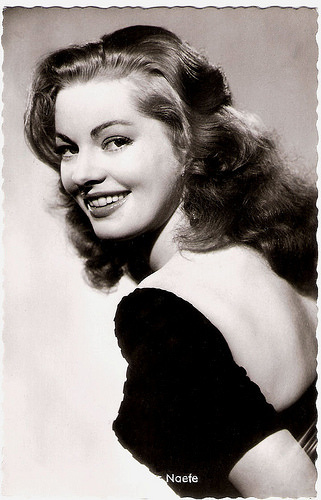
German card by Kolibri-Verlag, no. 2975.
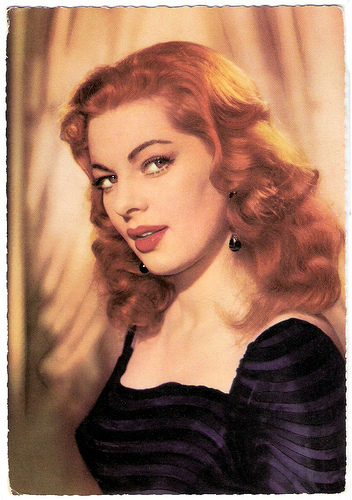
German postcard by ISV, no. C 4. Photo: Divina / Gloria / Grimm.
Tumultuous Marriage
Jester-Helene Naefe was born in 1924 in Vienna, Austria. She was the daughter of a truck driver, Herbert Naefe.
At the age of 16, Jester went to Berlin to follow acting lessons at the Ackermann Theater School. Soon she appeared on stage in the Breslauer Schauspielhaus in Breslau and in the Intimen Theater in Hamburg.
In 1948 producer-director Rolf Meyer gave her her first film part in the short film Sie sind nicht gemeint/You Were Not Meant (Answald Krüger, 1948) with Erik Ode.
This debut was soon followed by more secondary roles in Diese nacht vergess ich nie/I'll Never Forget That Night (Johannes Meyer, 1949) with Gustav Fröhlich , Der bagnosträfling/The Prisoner (Gustav Fröhlich, 1949) with Paul Dahlke, Wer bist du, den ich liebe?/Who Is This Person I Love? (Géza von Bolváry, 1949) with Iván Petrovich , and Das fräulein und der vagabund/The Girl and the Tramp (Albert Benitz, 1949) with Hardy Krüger .
In 1949 she married the rich, Hungarian business entrepreneur Alfred Tauszky. Jester stopped making films to concentrate on family life.
The marriage was tumultuous: Tauszky slapped her in public during a reception in Bad Oldesloe. In 1951 the couple had to leave Hamburg for Rome, when Tauszky was prosecuted for tax evasion.
Naefe and Tauszky had two daughters, Vivian (1952) and Silvia (born 1953). In 1953 Tauszky deserted his family and fled to Caracas, Venezuela. Jester returned with her daughters to Germany, first to Hamburg, later to München (Munich).
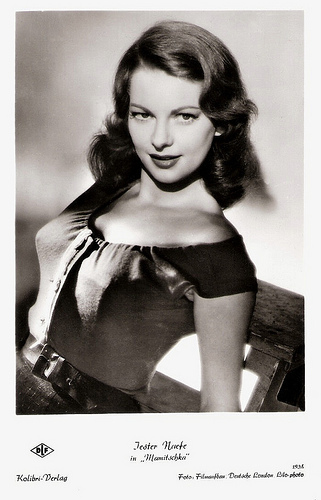
German card by Kolibri-Verlag, no. 1528. Photo: Filmaufbau / Deutsche London / Lilo-photo. Still from Mamitschka (Rolf Thiele, 1955).
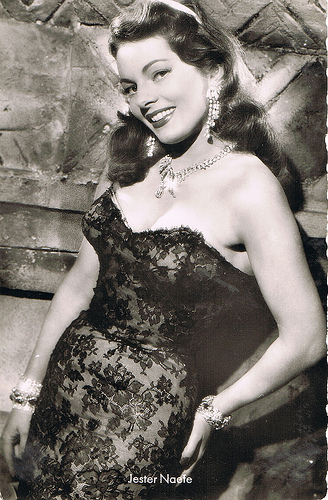
German postcard by Kolibri-Verlag. Collection: Meiter.
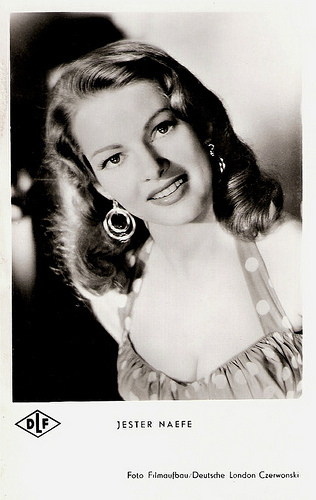
German postcard by Kunst und Bild, Berlin, no. I 413. Photo: Filmaufbau / Deutsche London / Czerwonski. Publicity still for Mamitschka (Rolf Thiele, 1955).
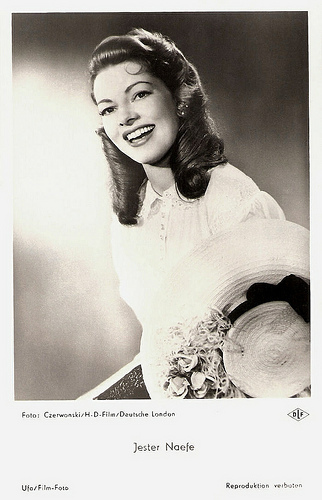
German postcard by Ufa, Berlin-Tempelhof, no. FK 2151. Photo: Czerwonski / H-D-Film / Deutsche London.
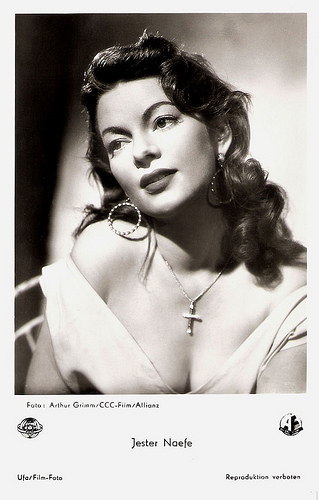
German postcard by Ufa, Berlin-Tempelhof, no. FK 1454. Photo: Arthur Grimm / CCC-Film / Allianz. Publicity still for Stern von Rio/Star from Rio (Kurt Neumann, 1955).
Sand, Love and Salt
Jester Naefe took up her film career in 1954 and the flamboyant beauty would make twelve films in the following three years.
Among these films were Die Kleine Stadt will schlafen gehen/The Little Town Will Go to Sleep (Hans H. König, 1954), Le destructeur/Das bekenntnis der Ina Kahr/Confession of Ina Kahr (Georg Wilhelm Pabst, 1954), co-starring with Curd Jürgens , Stern von Rio/Star from Rio (Kurt Neumann, 1955) with Willy Fritsch , and Die Goldene Brücke/The Golden Bridge (Paul Verhoeven, 1956) with Paul Hubschmid .
Her most famous role was as Lydia in the remake of the 1932 film operetta Der Kongress tanzt/Congress Dances (Franz Antel, 1955).
In 1957, during the shooting of the Italian-German coproduction La Ragazza della salina/Sand, Love and Salt (František Cáp, 1957) in Portoroz, Yugoslavia, she had a fighting scene with lead actress Isabella Corey . During the scene, she fell and hit the back of her head on a rock.
She soon started getting bad headaches, and the headaches were followed by temporary paralysis. Despite her illness she finished the film, co-starring Marcello Mastroianni .
Easter 1958 her illness seemed vanished, and she went to the USA for a TV show. Hollywood star Gregory Peck reportedly called her ‘one of the most attractive and beautiful women of the world’.
In 1959 she was treated again at a Munich hospital, and her illness was diagnosed as multiple sclerosis. Jester Naefe had to retire from the film business.
In the 1960s when the medical bills consumed all of her earnings, she retired to live with her mother, in her modest home in Wolfratshausen in Upper Bavaria.
After a long and painful period of illness she died in 1967 in Geretsried, near Wolfratshausen, forgotten by her colleagues and the public. She was only 42 although the obituaries gave her age as 37.
Her daughter Vivian Naefe is now a celebrated film and TV director.
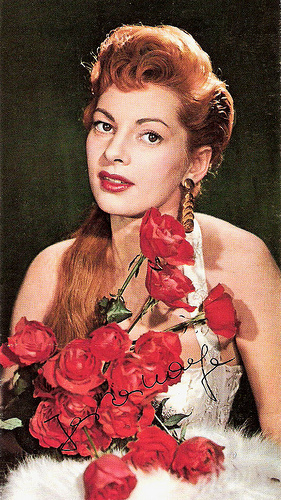
German card by Lux.
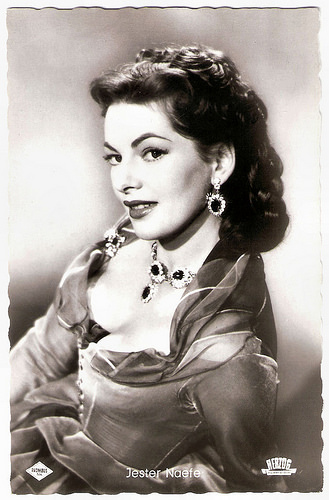
German postcard by Kolibri-Verlag, no. 2027. Photo: Rhombus / Herzog-Film / Czerwonski. Publicity still for Lumpazivagabundus/Gentleman-vagabond (Franz Antel, 1956).
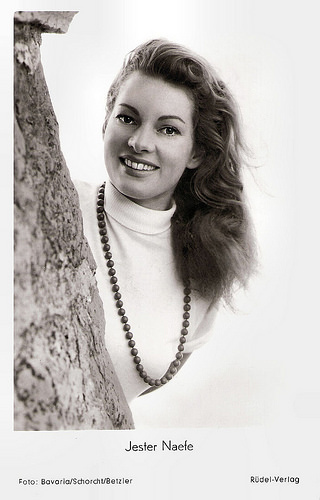
German postcard by Rüdel-Verlag, Hamburg-Bergedorf, no. 1907. Photo: Bavaria / Schorcht / Betzler. Publicity still for La ragazza della salina/Sand, Love and Salt (Frantisek Cáp, 1957).
Sources: Philippe Pelletier (CinéArtistes.com), Glamour Girls of the Silver Screen, Wikipedia (German), and .

German card by Kolibri-Verlag, no. 2975.

German postcard by ISV, no. C 4. Photo: Divina / Gloria / Grimm.
Tumultuous Marriage
Jester-Helene Naefe was born in 1924 in Vienna, Austria. She was the daughter of a truck driver, Herbert Naefe.
At the age of 16, Jester went to Berlin to follow acting lessons at the Ackermann Theater School. Soon she appeared on stage in the Breslauer Schauspielhaus in Breslau and in the Intimen Theater in Hamburg.
In 1948 producer-director Rolf Meyer gave her her first film part in the short film Sie sind nicht gemeint/You Were Not Meant (Answald Krüger, 1948) with Erik Ode.
This debut was soon followed by more secondary roles in Diese nacht vergess ich nie/I'll Never Forget That Night (Johannes Meyer, 1949) with Gustav Fröhlich , Der bagnosträfling/The Prisoner (Gustav Fröhlich, 1949) with Paul Dahlke, Wer bist du, den ich liebe?/Who Is This Person I Love? (Géza von Bolváry, 1949) with Iván Petrovich , and Das fräulein und der vagabund/The Girl and the Tramp (Albert Benitz, 1949) with Hardy Krüger .
In 1949 she married the rich, Hungarian business entrepreneur Alfred Tauszky. Jester stopped making films to concentrate on family life.
The marriage was tumultuous: Tauszky slapped her in public during a reception in Bad Oldesloe. In 1951 the couple had to leave Hamburg for Rome, when Tauszky was prosecuted for tax evasion.
Naefe and Tauszky had two daughters, Vivian (1952) and Silvia (born 1953). In 1953 Tauszky deserted his family and fled to Caracas, Venezuela. Jester returned with her daughters to Germany, first to Hamburg, later to München (Munich).

German card by Kolibri-Verlag, no. 1528. Photo: Filmaufbau / Deutsche London / Lilo-photo. Still from Mamitschka (Rolf Thiele, 1955).

German postcard by Kolibri-Verlag. Collection: Meiter.

German postcard by Kunst und Bild, Berlin, no. I 413. Photo: Filmaufbau / Deutsche London / Czerwonski. Publicity still for Mamitschka (Rolf Thiele, 1955).

German postcard by Ufa, Berlin-Tempelhof, no. FK 2151. Photo: Czerwonski / H-D-Film / Deutsche London.

German postcard by Ufa, Berlin-Tempelhof, no. FK 1454. Photo: Arthur Grimm / CCC-Film / Allianz. Publicity still for Stern von Rio/Star from Rio (Kurt Neumann, 1955).
Sand, Love and Salt
Jester Naefe took up her film career in 1954 and the flamboyant beauty would make twelve films in the following three years.
Among these films were Die Kleine Stadt will schlafen gehen/The Little Town Will Go to Sleep (Hans H. König, 1954), Le destructeur/Das bekenntnis der Ina Kahr/Confession of Ina Kahr (Georg Wilhelm Pabst, 1954), co-starring with Curd Jürgens , Stern von Rio/Star from Rio (Kurt Neumann, 1955) with Willy Fritsch , and Die Goldene Brücke/The Golden Bridge (Paul Verhoeven, 1956) with Paul Hubschmid .
Her most famous role was as Lydia in the remake of the 1932 film operetta Der Kongress tanzt/Congress Dances (Franz Antel, 1955).
In 1957, during the shooting of the Italian-German coproduction La Ragazza della salina/Sand, Love and Salt (František Cáp, 1957) in Portoroz, Yugoslavia, she had a fighting scene with lead actress Isabella Corey . During the scene, she fell and hit the back of her head on a rock.
She soon started getting bad headaches, and the headaches were followed by temporary paralysis. Despite her illness she finished the film, co-starring Marcello Mastroianni .
Easter 1958 her illness seemed vanished, and she went to the USA for a TV show. Hollywood star Gregory Peck reportedly called her ‘one of the most attractive and beautiful women of the world’.
In 1959 she was treated again at a Munich hospital, and her illness was diagnosed as multiple sclerosis. Jester Naefe had to retire from the film business.
In the 1960s when the medical bills consumed all of her earnings, she retired to live with her mother, in her modest home in Wolfratshausen in Upper Bavaria.
After a long and painful period of illness she died in 1967 in Geretsried, near Wolfratshausen, forgotten by her colleagues and the public. She was only 42 although the obituaries gave her age as 37.
Her daughter Vivian Naefe is now a celebrated film and TV director.

German card by Lux.

German postcard by Kolibri-Verlag, no. 2027. Photo: Rhombus / Herzog-Film / Czerwonski. Publicity still for Lumpazivagabundus/Gentleman-vagabond (Franz Antel, 1956).

German postcard by Rüdel-Verlag, Hamburg-Bergedorf, no. 1907. Photo: Bavaria / Schorcht / Betzler. Publicity still for La ragazza della salina/Sand, Love and Salt (Frantisek Cáp, 1957).
Sources: Philippe Pelletier (CinéArtistes.com), Glamour Girls of the Silver Screen, Wikipedia (German), and .
Published on May 12, 2014 23:00
May 11, 2014
Tilly Lus
Tilly Lus (1888-1971) was one of the great tragedy actresses of the Dutch theatre. She also appeared in five silent films.
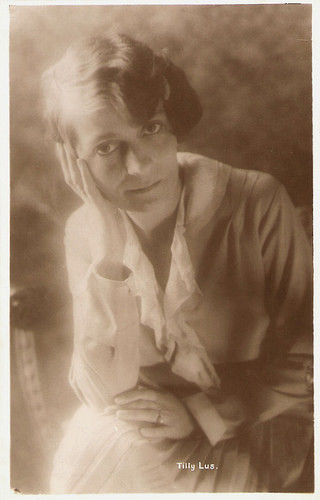
Dutch postcard by Weenenk & Snel, Den Haag (The Hague). Photo: Willem Coret.
Booed by the audience
Tilly Lus was born as Mathilda Gerardina Barbier in Zaandam, The Netherlands, in 1888.
She was a member of the actors family Barbier and a daughter of actress and dancer Johanna Catharina Peternella Barbier (1848-1927), widow of stage manager / actor / prompter Wilhelmus Hermanus Lus (1834-1882).
As a child on stage, Tilly already performed on stage. In 1907, she played the leading character Kleine Jan (Lottle John) in Herman Heijermans' neo-romantic fantasy play Uitkomst (Outcome), which was booed by the audience at the premiere in de Hollandsche Schouwburg.
She also played for the stage company Die Haghe Players, directed by Eduard Verkade .
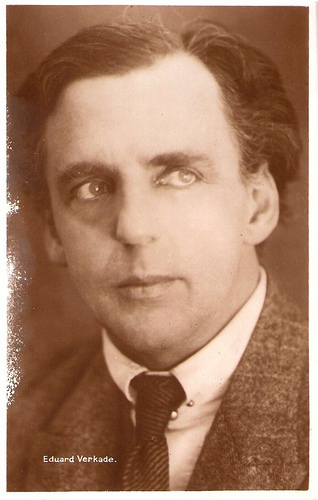
Eduard Verkade . Dutch postcard by Weenenk & Snel, Den Haag. Photo: Willem Coret. Collection: Egbert Barten.
Missing Films
During the era of the silent cinema, she played in five Dutch films, which are all missing now.
IMDb and Wikipedia mention three films, including two productions for the Film-Fabriek Anton Nöggerath (Anton Nöggerath film factory).
De bannelingen/The exiles (Leon Boedels, Caroline van Dommelen, 1911) was based on a novel by Oscar Wilde about a group of 19th century nihilists that wants to change the system in czaristic Russia.
The second film was Don Juan (Leon Boedels, 1913) featuring Willem van der Veer. An advertisement conserved at the Eye Film Institute states that the latter film was an "enormous success".
Her third film is the first Dutch horror thriller Het Geheim van het Slot Arco/The Secret of Arco Castle (Maurits Binger, Jan van Dommelen, 1915).
In this Hollandia Filmfabriek production, filmed in Austria, Lus co-starred opposite Jan van Dommelen .
Film in Nederland (Film in the NL), a site by Eye - Film Institute Netherlands also mentions: De paardrijdster/The Equestrienne (Maurits H. Binger, 1912), produced by Binger's company Maatschappij voor Artistieke Cinematografie, a precursor of his Filmfabriek Hollandia.
Her final film appearance was in a film insert for the play 't Speldenraapstertje (The little needle girl), a romantic comedy in three acts and an epilogue. The epilogue was the film insert, projected on a screen. Director Willy Mullens filmed this insert produced by his company Haghe Film for the stage company Het Princesse-Tooneel.
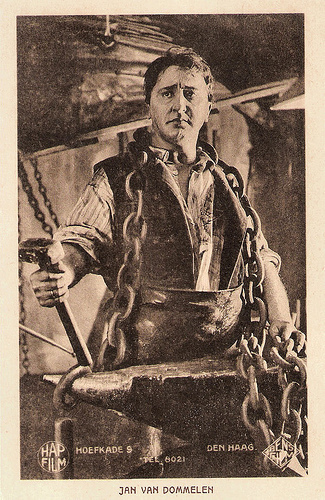
Jan van Dommelen. Dutch postcard by E & B. Photo by HAP Film / Bens Film, Den Haag. Publicity still for the film Schakels (Maurits Binger, 1920), based on a play by Herman Heijermans.
Great intensity and truthfulness
In the following decades, Tilly Lus became one of the most renowned performers of the Dutch stage.
According to the Dutch Theaterencyclopedie : "She was a major tragedienne, and was characterized by great intensity and truthfulness".
In the 1930s, she worked for the theatre company Centraal Tooneel and played in this period regularly with another legendary Dutch stage actress, Mary Dresselhuys.
Her most famous roles include Hannele in Gerhart Hauptmann's Hannele's Hemelvaart (Hannele's Ascension), Tsjie Moe in De gele mantel (The Yellow jacket), Mademoiselle in Jacques Deval's play Mademoiselle (1932), Harriet in Ludwig Biro's Masks and the title role in Renee Jeanne by Nora Jonuxi.
Her final role was Maria in Een familie in Nazareth (A Family in Nazareth) by Leonore Coffe and William Joyce Cowen at the Centraal Tooneel. In 1933 Lus was appointed Ridder in de Orde van Oranje-Nassau (Knight of the Order of Oranje-Nassau).
On 9 May 1940 she performed for the last time on stage. After the war she did not want to play anymore.
Since 1915, she was married to famous Dutch actor and director Cor Ruys. They had six children, including actress Louise Ruys.
In 1971, Tilly Lus died in The Hague at the age of 83.
Sources: Film in the Netherlands (Dutch), Theaterencyclopedie (Dutch), DBNL (Dutch), Wikipedia (Dutch) and .

Dutch postcard by Weenenk & Snel, Den Haag (The Hague). Photo: Willem Coret.
Booed by the audience
Tilly Lus was born as Mathilda Gerardina Barbier in Zaandam, The Netherlands, in 1888.
She was a member of the actors family Barbier and a daughter of actress and dancer Johanna Catharina Peternella Barbier (1848-1927), widow of stage manager / actor / prompter Wilhelmus Hermanus Lus (1834-1882).
As a child on stage, Tilly already performed on stage. In 1907, she played the leading character Kleine Jan (Lottle John) in Herman Heijermans' neo-romantic fantasy play Uitkomst (Outcome), which was booed by the audience at the premiere in de Hollandsche Schouwburg.
She also played for the stage company Die Haghe Players, directed by Eduard Verkade .

Eduard Verkade . Dutch postcard by Weenenk & Snel, Den Haag. Photo: Willem Coret. Collection: Egbert Barten.
Missing Films
During the era of the silent cinema, she played in five Dutch films, which are all missing now.
IMDb and Wikipedia mention three films, including two productions for the Film-Fabriek Anton Nöggerath (Anton Nöggerath film factory).
De bannelingen/The exiles (Leon Boedels, Caroline van Dommelen, 1911) was based on a novel by Oscar Wilde about a group of 19th century nihilists that wants to change the system in czaristic Russia.
The second film was Don Juan (Leon Boedels, 1913) featuring Willem van der Veer. An advertisement conserved at the Eye Film Institute states that the latter film was an "enormous success".
Her third film is the first Dutch horror thriller Het Geheim van het Slot Arco/The Secret of Arco Castle (Maurits Binger, Jan van Dommelen, 1915).
In this Hollandia Filmfabriek production, filmed in Austria, Lus co-starred opposite Jan van Dommelen .
Film in Nederland (Film in the NL), a site by Eye - Film Institute Netherlands also mentions: De paardrijdster/The Equestrienne (Maurits H. Binger, 1912), produced by Binger's company Maatschappij voor Artistieke Cinematografie, a precursor of his Filmfabriek Hollandia.
Her final film appearance was in a film insert for the play 't Speldenraapstertje (The little needle girl), a romantic comedy in three acts and an epilogue. The epilogue was the film insert, projected on a screen. Director Willy Mullens filmed this insert produced by his company Haghe Film for the stage company Het Princesse-Tooneel.

Jan van Dommelen. Dutch postcard by E & B. Photo by HAP Film / Bens Film, Den Haag. Publicity still for the film Schakels (Maurits Binger, 1920), based on a play by Herman Heijermans.
Great intensity and truthfulness
In the following decades, Tilly Lus became one of the most renowned performers of the Dutch stage.
According to the Dutch Theaterencyclopedie : "She was a major tragedienne, and was characterized by great intensity and truthfulness".
In the 1930s, she worked for the theatre company Centraal Tooneel and played in this period regularly with another legendary Dutch stage actress, Mary Dresselhuys.
Her most famous roles include Hannele in Gerhart Hauptmann's Hannele's Hemelvaart (Hannele's Ascension), Tsjie Moe in De gele mantel (The Yellow jacket), Mademoiselle in Jacques Deval's play Mademoiselle (1932), Harriet in Ludwig Biro's Masks and the title role in Renee Jeanne by Nora Jonuxi.
Her final role was Maria in Een familie in Nazareth (A Family in Nazareth) by Leonore Coffe and William Joyce Cowen at the Centraal Tooneel. In 1933 Lus was appointed Ridder in de Orde van Oranje-Nassau (Knight of the Order of Oranje-Nassau).
On 9 May 1940 she performed for the last time on stage. After the war she did not want to play anymore.
Since 1915, she was married to famous Dutch actor and director Cor Ruys. They had six children, including actress Louise Ruys.
In 1971, Tilly Lus died in The Hague at the age of 83.
Sources: Film in the Netherlands (Dutch), Theaterencyclopedie (Dutch), DBNL (Dutch), Wikipedia (Dutch) and .
Published on May 11, 2014 23:00
May 10, 2014
René Louis Lafforgue
Colourful French singer, composer and author René-Louis Lafforgue (1928-1967) was also a well-known actor in film, theatre and television. Only 39, the popular singer-songwriter died in a car crash on the road from Albi to Castres.
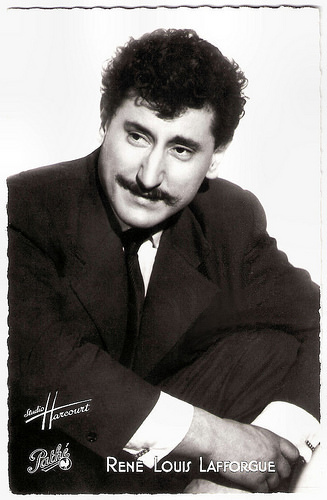
French postcard by Pathé. Photo: Studio Harcourt / Pathé.
Bonjour sourire!
René-Louis Lafforgue was born in San Sebastian, Spain in 1928 in a family of anarchist activists of Basque origin. During the Spanish civil war, his family went in exile in France.
In WWII, he participated in the French Resistance with his brother Sylvain. In 1944, the 16-years old Sylvain was killed fighting for freedom.
After the war, René Louis did several jobs, and finally became a singer-songwriter. He appeared in the shows of Georges Brassens, and performed with him at the Olympia.
In 1948, stage director Charles Dullin hired him as an actor. The following year, he toured around Europe with the mime artist Marcel Marceau.
He made his film debut in a bit part in Sous le ciel de Paris/Under the sky of Paris (Julien Duvivier, 1951) with Brigitte Auber . With his curls and small moustache he was very recognizable.
In 1954, he won the Grand Prix of the French Chanson in Deauville, which marked the beginning of his fame. Lafforgue wrote and performed such popular songs as Julie la Rousse (1956) and Poseur de rails (Platelayer) (1957).
He sang his songs in films like Bonjour sourire!/Hello smile! (Claude Sautet, 1956) and the comedy Julie la rousse/Julie the Redhead (Claude Boissol, 1959), which was based on his hit song.
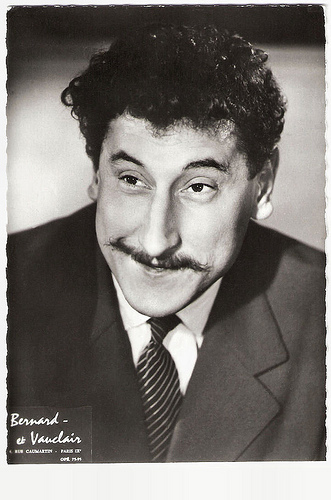
French postcard by Editions P.I., Paris, offered by Les Carbones Korès 'Carboplane', no. 855. Photo: Bernard et Vauclair, Paris.
The Lovers of Teruel
René-Louis Lafforgue played one of the leading parts in the film La pendule à Salomon/The Salomon Pendulum (Vicky Ivernel, 1960).
Two years later he starred again in the musical Les amants de Teruel/The Lovers of Teruel (Raymond Rouleau, 1962), opposite Ludmilla Tchérina . He was also the co-author of this special film.
Michael Smith at IMDb : “The Lovers of Teruel is the best film I have ever seen. Saw it about 15 times. It is the kind of film one can see over and over - like a great opera. Every frame is perfectly composed. The first time I saw it, 44 years ago, I sat through it twice because of the music by Mikos Theodorakis. Great acting from the entire cast. Great story - emotionally wrenching.”
In 1962, Lafforgue created the cabaret ‘L'École buissonnière’ in Paris, where young talents as Guy Bedos, Paul Préboist and Pierre Louki performed. The cabaret in Saint-Germain de Prez became a favourite venue for anarchists and pacifists, for whom he hosted many festivals.
He continued to appear in films, such as in the horror comedy La grande frousse/The Big Scare (Jean-Pierre Mocky, 1964) with Bourvil , and in La communale/Public School (Jean L'Hôte, 1965) with Robert Dhéry.
His last screen appearance was in the Canadian TV series L'éventail de Séville/The range of Seville (René Wheeler, Paul-Jacques Bonzon, 1968). During the production of this series, in 1967, René-Louis Lafforgue was killed in a car accident on highway 118, between Albi and Castres. He was only 39 years.
After his death, the cabaret L'École buissonnière was managed by his wife, Claudie.
René Louis Lafforgue sings Julie La Rousse. Source: Holdabaum (YouTube).
Sources: Dr. Tony Shaw, Michael Smith (IMDb), Wikipedia (French) and .

French postcard by Pathé. Photo: Studio Harcourt / Pathé.
Bonjour sourire!
René-Louis Lafforgue was born in San Sebastian, Spain in 1928 in a family of anarchist activists of Basque origin. During the Spanish civil war, his family went in exile in France.
In WWII, he participated in the French Resistance with his brother Sylvain. In 1944, the 16-years old Sylvain was killed fighting for freedom.
After the war, René Louis did several jobs, and finally became a singer-songwriter. He appeared in the shows of Georges Brassens, and performed with him at the Olympia.
In 1948, stage director Charles Dullin hired him as an actor. The following year, he toured around Europe with the mime artist Marcel Marceau.
He made his film debut in a bit part in Sous le ciel de Paris/Under the sky of Paris (Julien Duvivier, 1951) with Brigitte Auber . With his curls and small moustache he was very recognizable.
In 1954, he won the Grand Prix of the French Chanson in Deauville, which marked the beginning of his fame. Lafforgue wrote and performed such popular songs as Julie la Rousse (1956) and Poseur de rails (Platelayer) (1957).
He sang his songs in films like Bonjour sourire!/Hello smile! (Claude Sautet, 1956) and the comedy Julie la rousse/Julie the Redhead (Claude Boissol, 1959), which was based on his hit song.

French postcard by Editions P.I., Paris, offered by Les Carbones Korès 'Carboplane', no. 855. Photo: Bernard et Vauclair, Paris.
The Lovers of Teruel
René-Louis Lafforgue played one of the leading parts in the film La pendule à Salomon/The Salomon Pendulum (Vicky Ivernel, 1960).
Two years later he starred again in the musical Les amants de Teruel/The Lovers of Teruel (Raymond Rouleau, 1962), opposite Ludmilla Tchérina . He was also the co-author of this special film.
Michael Smith at IMDb : “The Lovers of Teruel is the best film I have ever seen. Saw it about 15 times. It is the kind of film one can see over and over - like a great opera. Every frame is perfectly composed. The first time I saw it, 44 years ago, I sat through it twice because of the music by Mikos Theodorakis. Great acting from the entire cast. Great story - emotionally wrenching.”
In 1962, Lafforgue created the cabaret ‘L'École buissonnière’ in Paris, where young talents as Guy Bedos, Paul Préboist and Pierre Louki performed. The cabaret in Saint-Germain de Prez became a favourite venue for anarchists and pacifists, for whom he hosted many festivals.
He continued to appear in films, such as in the horror comedy La grande frousse/The Big Scare (Jean-Pierre Mocky, 1964) with Bourvil , and in La communale/Public School (Jean L'Hôte, 1965) with Robert Dhéry.
His last screen appearance was in the Canadian TV series L'éventail de Séville/The range of Seville (René Wheeler, Paul-Jacques Bonzon, 1968). During the production of this series, in 1967, René-Louis Lafforgue was killed in a car accident on highway 118, between Albi and Castres. He was only 39 years.
After his death, the cabaret L'École buissonnière was managed by his wife, Claudie.
René Louis Lafforgue sings Julie La Rousse. Source: Holdabaum (YouTube).
Sources: Dr. Tony Shaw, Michael Smith (IMDb), Wikipedia (French) and .
Published on May 10, 2014 23:00
May 9, 2014
Rudi Carrell
Tonight is the Grand Final of the
2014 Eurovision Song Contest
, which takes place in Copenhagen, Denmark. 26 countries will be in the Grand Final. The Netherlands are represented this year by The Common Linnets a.k.a. Ilse de Lange and Waylon with the country song Calm after the Storm, which we really like. 54 years ago television show master, actor and singer Rudi Carrell (1934-2006) was the Dutch participant. He ended 12th out of 13. After his breakthrough in the Netherlands, Carrell went to Germany and gained enormous popularity there on television. He was the first presenter to attract a TV audience of 20 million Germans, one quarter of the total population. He also acted in several German films. After his death, Carrell was hailed as the greatest TV entertainer in Europe.
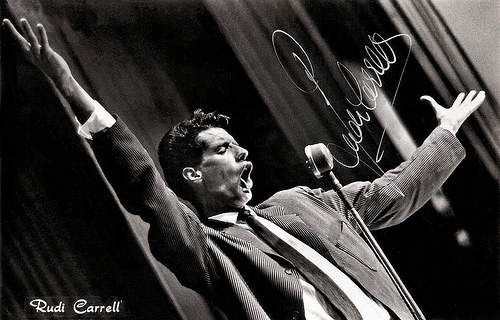
Dutch postcard.
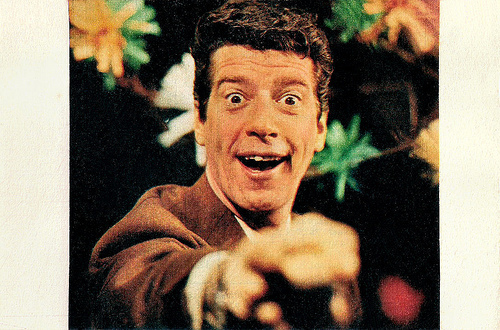
Dutch postcard.
Entertainer, Magician and Ventriloquist
Rudi Carrell was born as Rudolf Wijbrand Kesselaar in Alkmaar, the Dutch cheese capital, in 1934. He was the eldest of four children of Andries Kesselaar and his wife Catharina Houtkooper.
His father was an entertainer with the stage name André Carrell, his grandfather was a comic. By the time Rudi was 17, he was an accomplished magician and ventriloquist. In 1953 Rudi was deputising for his father when André had double booked himself.
Rudi made an effortless transition from stage to studio and in 1959 he hosted his own TV show, the Rudi Carrell Show.
In 1960 he represented the Netherlands at the Eurovision Song Contest with the song Wat een geluk/How Lucky and finished 12th out of 13 scoring just 2 points.
He had more luck as a show master. In 1963 he won the Nipkov Award of the Dutch TV critics and in 1964 an episode of the Rudi Carrell Show won the prestigious Silver Rose at the Montreux Television Festival.
This episode was shot on an artificial, uninhabited island, where Robinson Crusoe (Carrell) and his monkey Friday get a visit from a mermaid, played by singer Esther Ofarim.
The success of the show led him to Germany in 1965, where he would host the Rudi Carrell Show and many other shows until 2002. His work ranged from game shows, through comedy, variety, and current affairs. His timing and his perfect mastery of the script made him the darling of German audiences.
His show was also pretty popular in some other European non-German speaking countries like Slovenia.
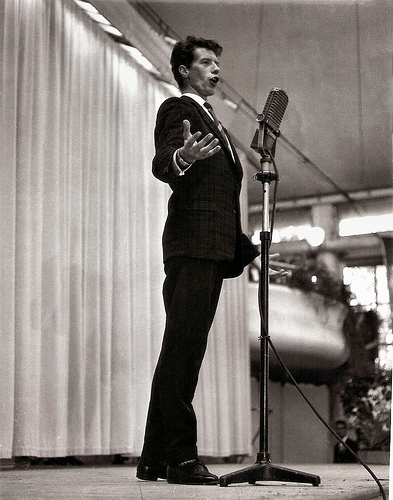
Dutch postcard.
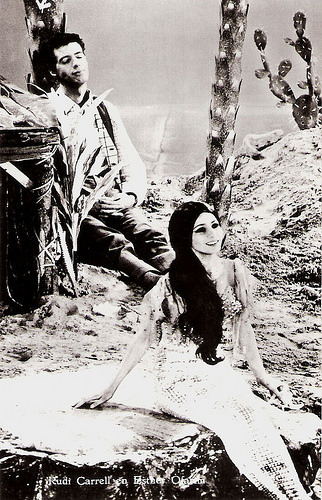
Dutch postcard by Int. Filmpers, Amsterdam, no. 1178. Photo: Phonogram. Still from the episode of the Rudi Carrell Show which won the Silver Rose award of the Montreux television festival 1964. Carrell as Robinson Crusoe who gets a visit from mermaid Esther Ofarim.
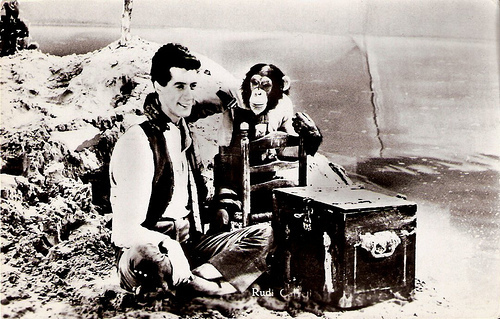
Dutch postcard by Phonogram / Gebr. Spanjersberg N.V., Rotterdam (SPARO), no. 1210. Photo: still from the episode of the Rudi Carrell Show that won the prestigious Silver Rose of the Montreux Television Festival 1964. Robinson Crusoe (Carrell) and his monkey Friday.
Cross-dressing Farces
Rudi Carrell acted in several German films. He was the lead in a series of cross-dressing farces: Wenn die tollen Tanten kommen/When the Mad Aunts Are Coming (Franz Josef Gottlieb, 1970) with Ilja Richter, Tante Trude aus Buxtehude/Aunt Trude From Buxtehude (Franz Josef Gottlieb, 1971) with Theo Lingen , and Die Tollen Tanten schlagen zu/The Mad Aunts Strike Out (1971, Franz Josef Gottlieb).
Other slapstick comedies were Rudi, benimm dich/Behave, Rudi (Franz Josef Gottlieb, 1971) with Chris Roberts, Hochwürden drückt ein Auge zu/Reverend Closes an Eye (Harald Vock, 1971) starring schlager singer Roy Black , and Crazy - total verrückt/Crazy - Completely Mad (Franz Josef Gottlieb, 1973) opposite former teen idol Cornelia - Conny - Froboess .
In those film comedies he was called ‘Der Rudi’, as he was in real life referred to in every pub and café.
The comedies attracted good audiences, but after 1973 he only incidentally made a film, including Starke Zeiten/Heavy Times (Rolf Olsen a.o., 1988).
He was also a pop singer with a number of hits. Wann wird`s mal wieder richtig Sommer?/When Will It Be A Real Summer Again? became a big hit in 1975. It was based on the American hit song City of New Orleans by Steve Goodman and made famous by Arlo Guthrie.
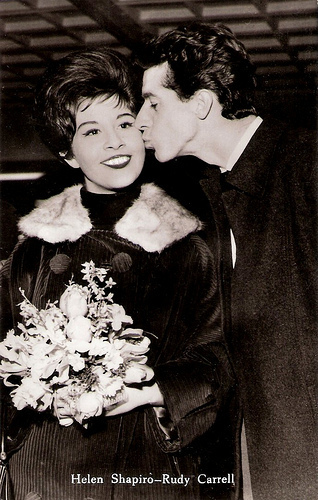
With Helen Shapiro . Dutch postcard by Sparo (Gebr. Spanjersberg N.V., Rotterdam). Sent by mail in the Netherlands in 1966. Photo: Columbia.
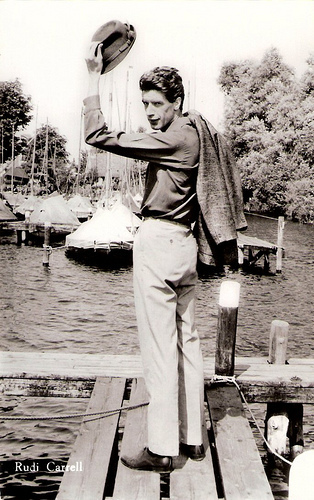
Dutch postcard by Hercules, Haarlem, no. 852.
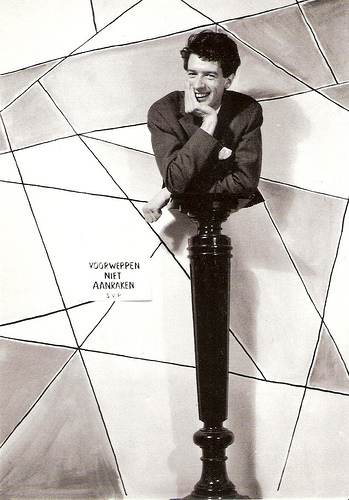
Dutch postcard by Art Unlimited, Amsterdam, no. B 1753, 1993. Photo: Dirk de Herder, 1962.
Outrage
A sketch on Rudi’s Tagesshow/Rudi's Daily Show (1984) provoked a serious diplomatic incident with Iran. A crowd of women threw bras and knickers at a mock-up of the Ayatollah Khomeini, at that time Iran’s spiritual as well as lay leader. The outrage in Tehran brought thousands on to the streets, led to the expulsion of two German diplomats, the closure of the Iranian consulates in Berlin, Hamburg and Frankfurt, the cancellation of flights between Bonn, then the West German capital, and Tehran.
An intervention from the then Dutch Foreign Minister stopped the scene being repeated on Dutch television. Carrell came under threat from fundamentalists, until he officially apologized in 1987.
He received many awards in the Netherlands and Germany, amongst others the Bundesverdienstkreuz (the only award given by the Federal Republic of Germany, for extraordinary achievements in politics or culture) in 1985.
Although living and working in Germany for 40 years he always spoke with a heavy Dutch accent. He smoked 60 cigarettes a day, and in 2005 he had lung cancer diagnosed. In a farewell TV appearance in 2006 he was presented with Germany’s highest TV award, the Golden Camera.
He also received the Bundesverdienstkreuz, Germany's Cross of Merit, for his achievements in German-Dutch relations in 1985, and he was given the Honorary Rose at the Festival of Montreux for his lifetime achievements in 2001.
Rudi Carrell died in 2006 in Bremen, Germany. He had been married three times. His wives were Truus de Vries (1957-1973) with whom he had two children, Annemieke and Caroline; Anke Bobbert (1974-2000) with whom he had a son, Alexander; and Simone Felischak (2002-2006).
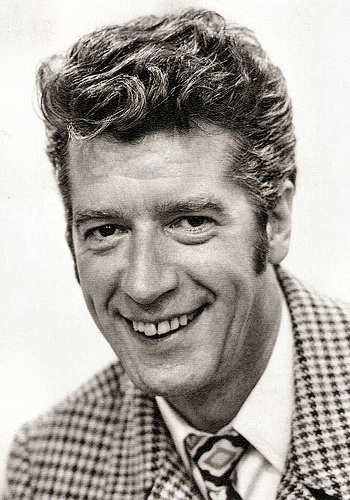
German card by Süddeutscher Rundfunk, Stuttgart. Photo: Hugo Jehle.
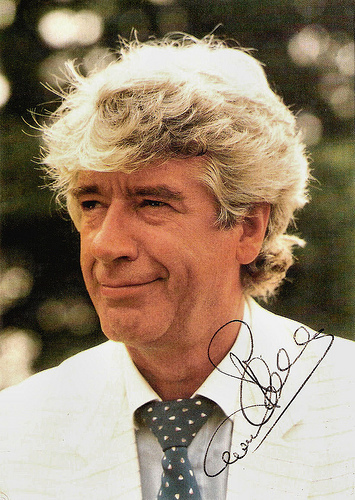
German postcard by Westdeutschen Rundfunk, Köln. Photo: R. Rutgers.
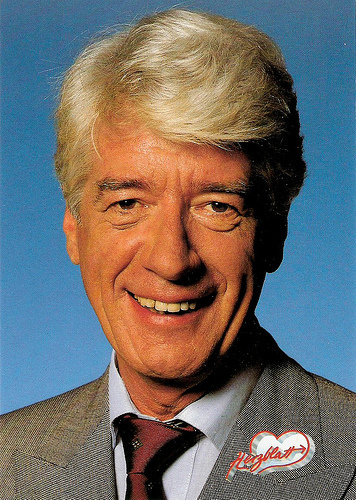
German postcard by Thomas Klinger, München. Photo: Bayerischer Rundfunk.
Rudi Carrell sings the song Wat een geluk/How Lucky at the 1960 Eurovision Song Contest. Source: huelezelf (YouTube).
Sources: Times Online, Wikipedia, Birth Television Archive and .

Dutch postcard.

Dutch postcard.
Entertainer, Magician and Ventriloquist
Rudi Carrell was born as Rudolf Wijbrand Kesselaar in Alkmaar, the Dutch cheese capital, in 1934. He was the eldest of four children of Andries Kesselaar and his wife Catharina Houtkooper.
His father was an entertainer with the stage name André Carrell, his grandfather was a comic. By the time Rudi was 17, he was an accomplished magician and ventriloquist. In 1953 Rudi was deputising for his father when André had double booked himself.
Rudi made an effortless transition from stage to studio and in 1959 he hosted his own TV show, the Rudi Carrell Show.
In 1960 he represented the Netherlands at the Eurovision Song Contest with the song Wat een geluk/How Lucky and finished 12th out of 13 scoring just 2 points.
He had more luck as a show master. In 1963 he won the Nipkov Award of the Dutch TV critics and in 1964 an episode of the Rudi Carrell Show won the prestigious Silver Rose at the Montreux Television Festival.
This episode was shot on an artificial, uninhabited island, where Robinson Crusoe (Carrell) and his monkey Friday get a visit from a mermaid, played by singer Esther Ofarim.
The success of the show led him to Germany in 1965, where he would host the Rudi Carrell Show and many other shows until 2002. His work ranged from game shows, through comedy, variety, and current affairs. His timing and his perfect mastery of the script made him the darling of German audiences.
His show was also pretty popular in some other European non-German speaking countries like Slovenia.

Dutch postcard.

Dutch postcard by Int. Filmpers, Amsterdam, no. 1178. Photo: Phonogram. Still from the episode of the Rudi Carrell Show which won the Silver Rose award of the Montreux television festival 1964. Carrell as Robinson Crusoe who gets a visit from mermaid Esther Ofarim.

Dutch postcard by Phonogram / Gebr. Spanjersberg N.V., Rotterdam (SPARO), no. 1210. Photo: still from the episode of the Rudi Carrell Show that won the prestigious Silver Rose of the Montreux Television Festival 1964. Robinson Crusoe (Carrell) and his monkey Friday.
Cross-dressing Farces
Rudi Carrell acted in several German films. He was the lead in a series of cross-dressing farces: Wenn die tollen Tanten kommen/When the Mad Aunts Are Coming (Franz Josef Gottlieb, 1970) with Ilja Richter, Tante Trude aus Buxtehude/Aunt Trude From Buxtehude (Franz Josef Gottlieb, 1971) with Theo Lingen , and Die Tollen Tanten schlagen zu/The Mad Aunts Strike Out (1971, Franz Josef Gottlieb).
Other slapstick comedies were Rudi, benimm dich/Behave, Rudi (Franz Josef Gottlieb, 1971) with Chris Roberts, Hochwürden drückt ein Auge zu/Reverend Closes an Eye (Harald Vock, 1971) starring schlager singer Roy Black , and Crazy - total verrückt/Crazy - Completely Mad (Franz Josef Gottlieb, 1973) opposite former teen idol Cornelia - Conny - Froboess .
In those film comedies he was called ‘Der Rudi’, as he was in real life referred to in every pub and café.
The comedies attracted good audiences, but after 1973 he only incidentally made a film, including Starke Zeiten/Heavy Times (Rolf Olsen a.o., 1988).
He was also a pop singer with a number of hits. Wann wird`s mal wieder richtig Sommer?/When Will It Be A Real Summer Again? became a big hit in 1975. It was based on the American hit song City of New Orleans by Steve Goodman and made famous by Arlo Guthrie.

With Helen Shapiro . Dutch postcard by Sparo (Gebr. Spanjersberg N.V., Rotterdam). Sent by mail in the Netherlands in 1966. Photo: Columbia.

Dutch postcard by Hercules, Haarlem, no. 852.

Dutch postcard by Art Unlimited, Amsterdam, no. B 1753, 1993. Photo: Dirk de Herder, 1962.
Outrage
A sketch on Rudi’s Tagesshow/Rudi's Daily Show (1984) provoked a serious diplomatic incident with Iran. A crowd of women threw bras and knickers at a mock-up of the Ayatollah Khomeini, at that time Iran’s spiritual as well as lay leader. The outrage in Tehran brought thousands on to the streets, led to the expulsion of two German diplomats, the closure of the Iranian consulates in Berlin, Hamburg and Frankfurt, the cancellation of flights between Bonn, then the West German capital, and Tehran.
An intervention from the then Dutch Foreign Minister stopped the scene being repeated on Dutch television. Carrell came under threat from fundamentalists, until he officially apologized in 1987.
He received many awards in the Netherlands and Germany, amongst others the Bundesverdienstkreuz (the only award given by the Federal Republic of Germany, for extraordinary achievements in politics or culture) in 1985.
Although living and working in Germany for 40 years he always spoke with a heavy Dutch accent. He smoked 60 cigarettes a day, and in 2005 he had lung cancer diagnosed. In a farewell TV appearance in 2006 he was presented with Germany’s highest TV award, the Golden Camera.
He also received the Bundesverdienstkreuz, Germany's Cross of Merit, for his achievements in German-Dutch relations in 1985, and he was given the Honorary Rose at the Festival of Montreux for his lifetime achievements in 2001.
Rudi Carrell died in 2006 in Bremen, Germany. He had been married three times. His wives were Truus de Vries (1957-1973) with whom he had two children, Annemieke and Caroline; Anke Bobbert (1974-2000) with whom he had a son, Alexander; and Simone Felischak (2002-2006).

German card by Süddeutscher Rundfunk, Stuttgart. Photo: Hugo Jehle.

German postcard by Westdeutschen Rundfunk, Köln. Photo: R. Rutgers.

German postcard by Thomas Klinger, München. Photo: Bayerischer Rundfunk.
Rudi Carrell sings the song Wat een geluk/How Lucky at the 1960 Eurovision Song Contest. Source: huelezelf (YouTube).
Sources: Times Online, Wikipedia, Birth Television Archive and .
Published on May 09, 2014 23:00
May 8, 2014
Christine Kaufmann
When she was seven Christine Kaufmann (1945) made her film debut in an adaptation of Im weißen Rößl/The White Horse Inn (1952). The girl with the sad eyes gained international recognition when she played the demanding role of a teenaged rape victim in Town Without Pity (1961). While playing the heroine of the big-budget Taras Bulba (1962), Kaufmann fell in love with her co-star, Tony Curtis. Today she is known as 'Germany's most beautiful grandmother'.
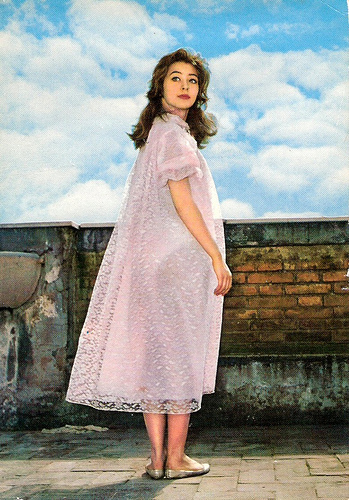
German postcard by Krüger, no. 902/60.
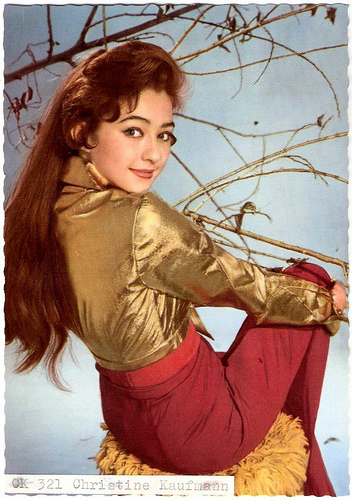
German postcard by Ufa, Berlin-Tempelhof, no. CK-321. Photo: Klaus Collignon / Ufa.
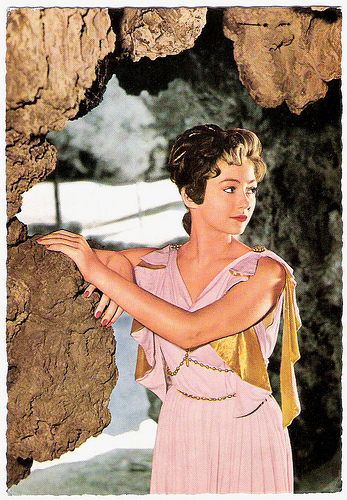
German postcard by WS-Druck, Wanne-Eickel, no. F 157.
Lolita
Christine Maria Kaufmann was born in Lengdorf, Styria in what is now Austria, in 1945. Her father was a German Luftwaffe officer and her mother a French doctor who gave up her practice to help further Christine's career.
She grew up in München (Munich) and trained as a ballerina at the Staatstheater am Gärtnerplatz and later at the Staatsopernballett(Munich Opera). She started her film career at the age of seven with a small role in the musical Im weißen Rößl/White Horse Inn ( Willi Forst , 1952).
The film which brought her fame was Rosen-Resli/Rose-Girl Resli (Harald Reinl, 1954), when she was only nine. The film was a gigantic success in post-war Germany and she moved millions of Germans to tears.
Soon she appeared in such films as Der schweigende Engel/The Silent Angel (Harald Reinl, 1954), Wenn die Alpenrosen blüh'n/When the Alpine Roses Bloom (Hans Deppe, Richard Häussler, 1955) with Hertha Feiler , and Ein Herz schlägt für Erika/A Heart Beats for Erika (Harald Reinl, 1956) with Grethe Weiser.
She gained international recognition when she played alongside Carla Gravina in Primo Amore/First Love (Mario Camerini, 1958), and with Steve Reeves in the Peplum Gli ultimi giorni di Pompei/The Last Days of Pompeii (Mario Bonnard, Sergio Leone uncredited), 1959), and with Kirk Douglas in Town Without Pity (Gottfried Reinhardt, 1961).
She won the Golden Globe that year as the Most Promising Newcomer for the latter film. The press of the period was less concerned with Kaufmann's histrionic skills than with the revealing bikini which she wore in her early scenes.
That year she also appeared opposite Gert Fröbe in the interesting thriller Via Mala (Paul May, 1961), and with Jean-Paul Belmondo in Un nommé La Rocca/A Man Names Rocca (Jean Becker, 1961).
The following year she appeared in the uneven escape film Escape from East Berlin (Robert Siodmak, 1962) opposite Don Murray, but she turned down the title role of Lolita (Stanley Kubrick, 1962).
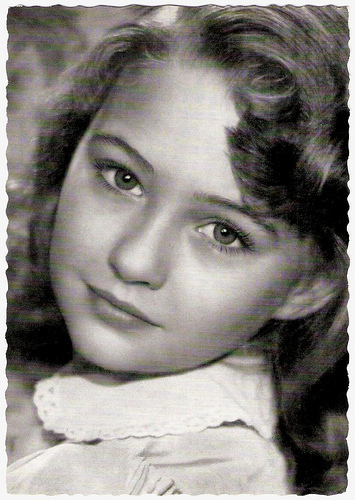
German postcard by Filmbilder-Vertrieb Ernst Freihoff, Essen. Retail price: 10 Pfg. Photo: Lantin / Panorama Film.
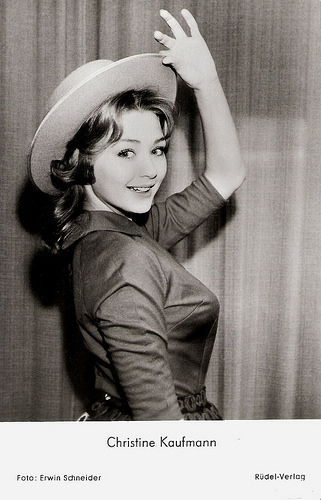
German postcard by Rüdel-Verlag, Hamburg-Bergedorf, no. 2986. Photo: Erwin Schneider.
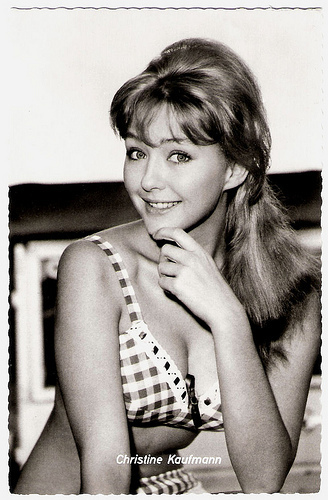
German postcard by Kolibri-Verlag, Minden/Westf., no. 1436.
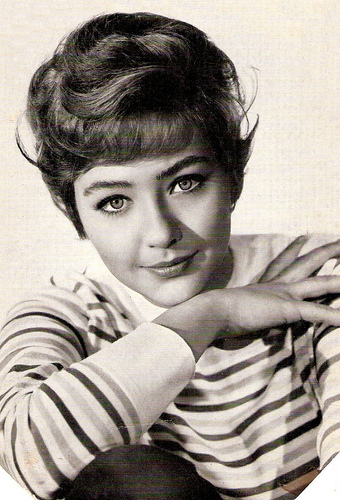
German postcard, no. 10. Photo: Melodie.
Beauty
Christine Kaufmann was 17 when she met Tony Curtis on the set of the big budget epic Taras Bulba (J. Lee Thompson, 1962) in Argentina. Curtis divorced his wife Janet Leigh and married Kaufmann in 1963. They appeared together in the frothy Universal comedy Wild and Wonderful (Michael Anderson, 1964).
She briefly retired from films to geve birth to two daughters, Alexandra (1964) and Allegra (1966). The pair divorced in 1968.
Kaufmann resumed her career in Germany, which she had interrupted during her marriage. The TV mini-series Wie ein Blitz/Like A Flash (Rolf von Sydow, 1960) became a huge success. On TV she also appeared in Krimis like Der Kommissar (1972) and Derrick (1977).
For the cinema she often worked with director Werner Schroeter and his star Magdalena Montezuma in such films as Der Tod der Maria Malibran/The Death of Maria Malibran (1971), Willow Springs (1973), Goldflocken/Gold Flakes (1976) and Tag der Idioten/Day of the Idiots (1981) with Carole Bouquet.
She also acted in several films by Rainer Werner Fassbinder like the TV film Welt am Draht/World on Wire (1973), Lili Marleen (1981) and Lola (1981).
Other international films were the Giallo Enigma rosso/Virgin Killer (Alberto Negrin, 1978) with Fabio Testi, the cult favourite Bagdad Café/Out of Rosenheim (Percy Adlon, 1987), and the comedy Haider lebt - 1. April 2021/Haider Lives - a April 2021 (Peter Kern, 2002).
In 1995, after posing nude for Playboy Magazine at the age of 54, she was nicknamed 'Germany's most beautiful grandmother'.
Christine Kaufmann regularly appears in TV series and also has her own line of cosmetics that sells well in Germany. She has written several books about beauty and health, as well as two autobiographies.
She lives in München and Hamburg.
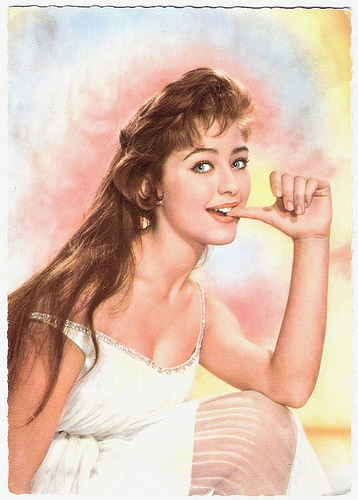
German postcard by Universum-Film Aktiengesellschaft (Ufa), Berlin-Tempelhof, no. CK 302. Photo: Klaus Collignon / Ufa.
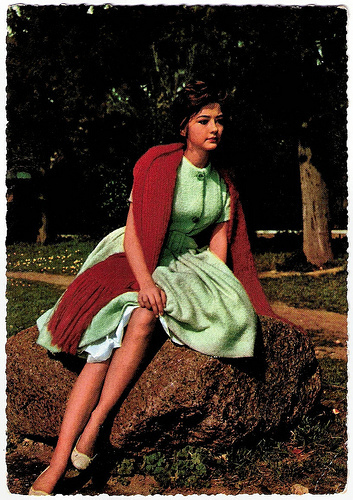
German postcard by Krüger, no. 902/61.
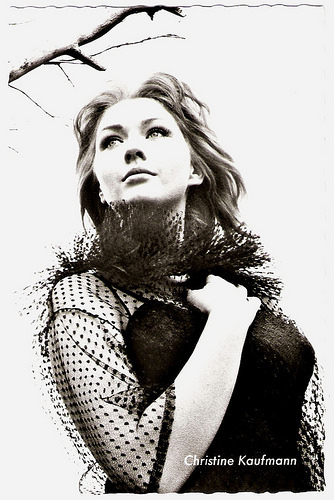
German postcard by Starpostkarten-Vertrieb Ernst Freihoff, Essen, no. 1013. Photo: Lothar Winkler.
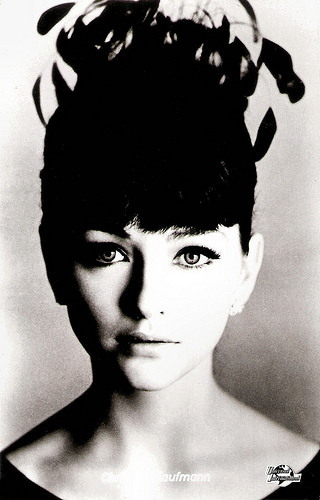
German postcard by Kolibri Fotokarte, Minden/Westf., no. 2396. Photo: Universal. Publicity still for Monsieur Cognac/Wild and Wonderful (Michael Anderson, 1964).
Scene of Taras Bulba (1962). Source: GSMovieMoments (YouTube).
Sources: Hal Erickson (AllMovie), and Wikipedia.

German postcard by Krüger, no. 902/60.

German postcard by Ufa, Berlin-Tempelhof, no. CK-321. Photo: Klaus Collignon / Ufa.

German postcard by WS-Druck, Wanne-Eickel, no. F 157.
Lolita
Christine Maria Kaufmann was born in Lengdorf, Styria in what is now Austria, in 1945. Her father was a German Luftwaffe officer and her mother a French doctor who gave up her practice to help further Christine's career.
She grew up in München (Munich) and trained as a ballerina at the Staatstheater am Gärtnerplatz and later at the Staatsopernballett(Munich Opera). She started her film career at the age of seven with a small role in the musical Im weißen Rößl/White Horse Inn ( Willi Forst , 1952).
The film which brought her fame was Rosen-Resli/Rose-Girl Resli (Harald Reinl, 1954), when she was only nine. The film was a gigantic success in post-war Germany and she moved millions of Germans to tears.
Soon she appeared in such films as Der schweigende Engel/The Silent Angel (Harald Reinl, 1954), Wenn die Alpenrosen blüh'n/When the Alpine Roses Bloom (Hans Deppe, Richard Häussler, 1955) with Hertha Feiler , and Ein Herz schlägt für Erika/A Heart Beats for Erika (Harald Reinl, 1956) with Grethe Weiser.
She gained international recognition when she played alongside Carla Gravina in Primo Amore/First Love (Mario Camerini, 1958), and with Steve Reeves in the Peplum Gli ultimi giorni di Pompei/The Last Days of Pompeii (Mario Bonnard, Sergio Leone uncredited), 1959), and with Kirk Douglas in Town Without Pity (Gottfried Reinhardt, 1961).
She won the Golden Globe that year as the Most Promising Newcomer for the latter film. The press of the period was less concerned with Kaufmann's histrionic skills than with the revealing bikini which she wore in her early scenes.
That year she also appeared opposite Gert Fröbe in the interesting thriller Via Mala (Paul May, 1961), and with Jean-Paul Belmondo in Un nommé La Rocca/A Man Names Rocca (Jean Becker, 1961).
The following year she appeared in the uneven escape film Escape from East Berlin (Robert Siodmak, 1962) opposite Don Murray, but she turned down the title role of Lolita (Stanley Kubrick, 1962).

German postcard by Filmbilder-Vertrieb Ernst Freihoff, Essen. Retail price: 10 Pfg. Photo: Lantin / Panorama Film.

German postcard by Rüdel-Verlag, Hamburg-Bergedorf, no. 2986. Photo: Erwin Schneider.

German postcard by Kolibri-Verlag, Minden/Westf., no. 1436.

German postcard, no. 10. Photo: Melodie.
Beauty
Christine Kaufmann was 17 when she met Tony Curtis on the set of the big budget epic Taras Bulba (J. Lee Thompson, 1962) in Argentina. Curtis divorced his wife Janet Leigh and married Kaufmann in 1963. They appeared together in the frothy Universal comedy Wild and Wonderful (Michael Anderson, 1964).
She briefly retired from films to geve birth to two daughters, Alexandra (1964) and Allegra (1966). The pair divorced in 1968.
Kaufmann resumed her career in Germany, which she had interrupted during her marriage. The TV mini-series Wie ein Blitz/Like A Flash (Rolf von Sydow, 1960) became a huge success. On TV she also appeared in Krimis like Der Kommissar (1972) and Derrick (1977).
For the cinema she often worked with director Werner Schroeter and his star Magdalena Montezuma in such films as Der Tod der Maria Malibran/The Death of Maria Malibran (1971), Willow Springs (1973), Goldflocken/Gold Flakes (1976) and Tag der Idioten/Day of the Idiots (1981) with Carole Bouquet.
She also acted in several films by Rainer Werner Fassbinder like the TV film Welt am Draht/World on Wire (1973), Lili Marleen (1981) and Lola (1981).
Other international films were the Giallo Enigma rosso/Virgin Killer (Alberto Negrin, 1978) with Fabio Testi, the cult favourite Bagdad Café/Out of Rosenheim (Percy Adlon, 1987), and the comedy Haider lebt - 1. April 2021/Haider Lives - a April 2021 (Peter Kern, 2002).
In 1995, after posing nude for Playboy Magazine at the age of 54, she was nicknamed 'Germany's most beautiful grandmother'.
Christine Kaufmann regularly appears in TV series and also has her own line of cosmetics that sells well in Germany. She has written several books about beauty and health, as well as two autobiographies.
She lives in München and Hamburg.

German postcard by Universum-Film Aktiengesellschaft (Ufa), Berlin-Tempelhof, no. CK 302. Photo: Klaus Collignon / Ufa.

German postcard by Krüger, no. 902/61.

German postcard by Starpostkarten-Vertrieb Ernst Freihoff, Essen, no. 1013. Photo: Lothar Winkler.

German postcard by Kolibri Fotokarte, Minden/Westf., no. 2396. Photo: Universal. Publicity still for Monsieur Cognac/Wild and Wonderful (Michael Anderson, 1964).
Scene of Taras Bulba (1962). Source: GSMovieMoments (YouTube).
Sources: Hal Erickson (AllMovie), and Wikipedia.
Published on May 08, 2014 23:00
May 7, 2014
Tatyana Samoylova (1934-2014)
Last Monday, 4 May 2014, Soviet actress Tatyana Samoylova died. She was called 'the Russian Audrey Hepburn'. Samoylova is best known for her title role in Anna Karenina (Aleksandr Zarkhi, 1967), based on the famous novel by Leo Tolstoy. Ten years earlier, she had had her breakthrough with Letyat zhuravli/The Cranes Are Flying (Mikhail Kalatozov, 1957), which won the Golden Palm at the Cannes Film Festival of 1958 - the first Russian film ever to do so. Tatyana Samoylova was 80.
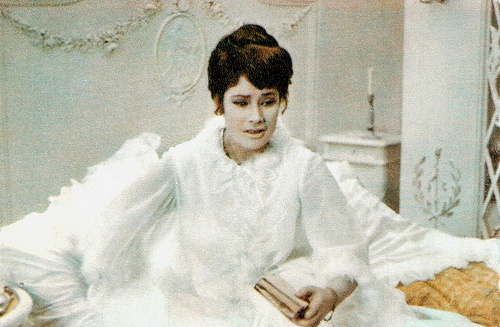
Russian postcard by Izdanije Byuro Propogandy Sovietskogo Kinoiskusstva, no. A 08345, 1969. This postcard was printed in an edition of 500,000 cards. Retail price was 6 kop. Photo: publicity still for Anna Karenina (Aleksandr Zarkhi, 1967).
The Cranes Are Flying
Tatyana Samoylova or Tatiana Samojlova was born Tatiana Evgenievna Samoilova (Татья́на Евге́ньевна Само́йлова) in Leningrad (St. Petersburg), Russia in 1934. Her father, Yevgeni Samojlov, was a notable Russian actor, Her mother, Zinaida Ilyinichna, was Jewish.
Young Samoylova studied music under the tutelage of her mother. During the Second World War, she escaped from the siege of Leningrad with her parents, and moved to Moscow. There she studied ballet and graduated from the Ballet School of Stanislavsky Theatre.
She was invited by Maya Plisetskaya to join the ballet school of Bolshoi Theatre, but she chose to be a dramatic actress. From 1953-1956 she studied at Shchukin Theatrical School, then at State Institute of Theatrical Art (GITIS), graduating in 1962, as actress. While a student, Samojlova made her film debut in Meksikanets/The Mexican (Vladimir Kaplunovskiy, 1955) with Daniil Sagal.
Samoylova shot to fame with the leading role as Veronika in Letyat zhuravli/The Cranes Are Flying (Mikhail Kalatozov, 1957) opposite Aleksey Batalov as Boris. The film tells a love story set during the early years of World War II. In spite of the initial cold reception by the Soviet officialdom, the film was loved by public in Russia and internationally. It became the first and only Russian film to be awarded the Golden Palm at the Cannes Film Festival.
Samoylova won a Special Mention at Cannes and was nominated for Best Foreign Actress BAFTA Film Award in 1959. She received many offers internationally, and was invited to work in Hollywood, but the Soviet government forced her to decline any jobs outside the Soviet Union.
In 1958, she made her stage debut at the Vakhtangov Theater in Moscow. She also appeared in another film by Kalatazov, Neotpravlennoye pismo/The Letter That Was Never Sent (Mikhail Kalatozov, 1959) with Evgeniy Urbanskiy.
Original Russian trailer for Letyat zhuravli/The Cranes Are Flying (Mikhail Kalatozov, 1957). Source: Ramil Orion (YouTube).
Anna Karenina
During the 1960s, Tatyana Samoylova's career stagnated due to overall stagnation in the USSR under Leonid Brezhnev.
In 1960 she lost her job with Mayakovsky Theatre in Moscow, and was practically unemployed for several years.
However, she did co-star in the Italian-Russian war film Italiani brava gente/Attack and Retreat (Giuseppe De Santis, 1964) with Arthur Kennedy. A chronicle of the unheralded and unsuccessful invasion of the Soviet Union by the Italian army during World War II.
Her next success came with the title role in Anna Karenina (Aleksandr Zarkhi, 1967), an adaptation of the eponymous novel by Leo Tolstoy. Samoylova starred as Anna Karenina opposite her ex-husband Vasili Lanovoy as Count Vronsky.
Dan Pavlides at AllMovie : "After several previous attempts by foreign directors who miss the mark, this Russian film version of Leo Tolstoy's classic novel Anna Karenina most accurately follows the Tolstoy novel and remains superior to all other versions to date."
During the 1980s and 1990s, Tatyana Samoylova had a lengthy pause in her film career. She made a comeback in several TV series in the 2000s.
Samojlova was designated People's Actress of Russia (1993). In 2007 she was awarded with a Lifetime Achievement Award at the 29th Moscow International Film Festival.
She was married four times, to Solomon Shulman, Vasili Lanovoy (1954-1958), Valeri Osipov (1959-1968), and to Edward Mashkovich (1968-1973). With Mashkovich, she had a son.
On 3 May 2014, the eve of her 80th birthday, Tatyana Samoylova was taken to a Moscow hospital in serious condition with coronary heart disease and hypertension. She died, one day later. Tatyana Samoylova was 80.
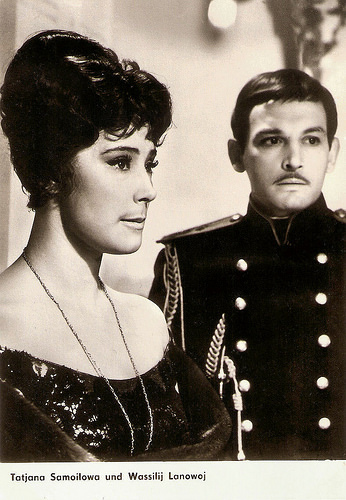
East-German postcard by VEB Progress Film-Vertrieb, Berlin, no. 3156, 1968. Retail price: 0,20 DM. Photo: Uhlenhut. Publicity still for Anna Karenina (Aleksandr Zarkhi, 1967) with Vasili Lanovoy.
Sources: Steve Shelokhonov (), Dan Pavlides (AllMovie), T Online (German), Wikipedia and .

Russian postcard by Izdanije Byuro Propogandy Sovietskogo Kinoiskusstva, no. A 08345, 1969. This postcard was printed in an edition of 500,000 cards. Retail price was 6 kop. Photo: publicity still for Anna Karenina (Aleksandr Zarkhi, 1967).
The Cranes Are Flying
Tatyana Samoylova or Tatiana Samojlova was born Tatiana Evgenievna Samoilova (Татья́на Евге́ньевна Само́йлова) in Leningrad (St. Petersburg), Russia in 1934. Her father, Yevgeni Samojlov, was a notable Russian actor, Her mother, Zinaida Ilyinichna, was Jewish.
Young Samoylova studied music under the tutelage of her mother. During the Second World War, she escaped from the siege of Leningrad with her parents, and moved to Moscow. There she studied ballet and graduated from the Ballet School of Stanislavsky Theatre.
She was invited by Maya Plisetskaya to join the ballet school of Bolshoi Theatre, but she chose to be a dramatic actress. From 1953-1956 she studied at Shchukin Theatrical School, then at State Institute of Theatrical Art (GITIS), graduating in 1962, as actress. While a student, Samojlova made her film debut in Meksikanets/The Mexican (Vladimir Kaplunovskiy, 1955) with Daniil Sagal.
Samoylova shot to fame with the leading role as Veronika in Letyat zhuravli/The Cranes Are Flying (Mikhail Kalatozov, 1957) opposite Aleksey Batalov as Boris. The film tells a love story set during the early years of World War II. In spite of the initial cold reception by the Soviet officialdom, the film was loved by public in Russia and internationally. It became the first and only Russian film to be awarded the Golden Palm at the Cannes Film Festival.
Samoylova won a Special Mention at Cannes and was nominated for Best Foreign Actress BAFTA Film Award in 1959. She received many offers internationally, and was invited to work in Hollywood, but the Soviet government forced her to decline any jobs outside the Soviet Union.
In 1958, she made her stage debut at the Vakhtangov Theater in Moscow. She also appeared in another film by Kalatazov, Neotpravlennoye pismo/The Letter That Was Never Sent (Mikhail Kalatozov, 1959) with Evgeniy Urbanskiy.
Original Russian trailer for Letyat zhuravli/The Cranes Are Flying (Mikhail Kalatozov, 1957). Source: Ramil Orion (YouTube).
Anna Karenina
During the 1960s, Tatyana Samoylova's career stagnated due to overall stagnation in the USSR under Leonid Brezhnev.
In 1960 she lost her job with Mayakovsky Theatre in Moscow, and was practically unemployed for several years.
However, she did co-star in the Italian-Russian war film Italiani brava gente/Attack and Retreat (Giuseppe De Santis, 1964) with Arthur Kennedy. A chronicle of the unheralded and unsuccessful invasion of the Soviet Union by the Italian army during World War II.
Her next success came with the title role in Anna Karenina (Aleksandr Zarkhi, 1967), an adaptation of the eponymous novel by Leo Tolstoy. Samoylova starred as Anna Karenina opposite her ex-husband Vasili Lanovoy as Count Vronsky.
Dan Pavlides at AllMovie : "After several previous attempts by foreign directors who miss the mark, this Russian film version of Leo Tolstoy's classic novel Anna Karenina most accurately follows the Tolstoy novel and remains superior to all other versions to date."
During the 1980s and 1990s, Tatyana Samoylova had a lengthy pause in her film career. She made a comeback in several TV series in the 2000s.
Samojlova was designated People's Actress of Russia (1993). In 2007 she was awarded with a Lifetime Achievement Award at the 29th Moscow International Film Festival.
She was married four times, to Solomon Shulman, Vasili Lanovoy (1954-1958), Valeri Osipov (1959-1968), and to Edward Mashkovich (1968-1973). With Mashkovich, she had a son.
On 3 May 2014, the eve of her 80th birthday, Tatyana Samoylova was taken to a Moscow hospital in serious condition with coronary heart disease and hypertension. She died, one day later. Tatyana Samoylova was 80.

East-German postcard by VEB Progress Film-Vertrieb, Berlin, no. 3156, 1968. Retail price: 0,20 DM. Photo: Uhlenhut. Publicity still for Anna Karenina (Aleksandr Zarkhi, 1967) with Vasili Lanovoy.
Sources: Steve Shelokhonov (), Dan Pavlides (AllMovie), T Online (German), Wikipedia and .
Published on May 07, 2014 23:00
May 6, 2014
Jean Gaven (1922-2014)
On 5 May 2014, French actor Jean Gaven has died. He appeared in more than sixty films between 1945 to 1996.
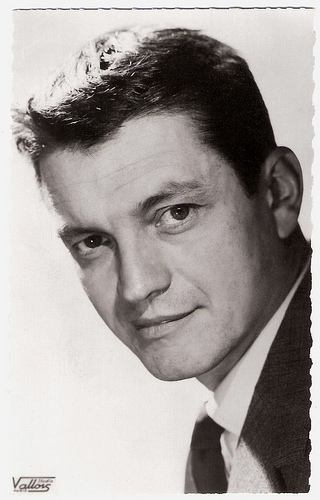
French postcard by Editions P.I., presented by Les Carbones Korès Carboplane, no. 910. Photo: Studio Vallois, Paris.
Histoire d'O
Jean Gaven was born in Saint-Rome de Cernon, France in 1922.
Gaven played leading and supporting roles on stage, screen and television.
Among his best known films are Si tous les gars du monde/If All the Guys in the World (Christian-Jacque, 1955), the SM erotic film Histoire d'O/The Story of O (Just Jaeckin, 1975) and the massive hit L'été meurtrier/One Deadly Summer (Jean Becker, 1983) with Isabelle Adjani .
French TV audiences loved him in title role of the series Maurin des Maures/The illustrious Maurin (Jean Canolle, Claude Daggers, 1970).
Gaven had been married to actress Dominique Wilms since 1957.
Jean Gaven was 92.
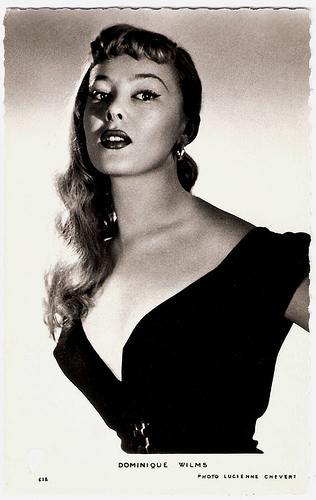
Dominique Wilms. French postcard by Editions P.I., Paris, no. 28G. Photo: Lucienne Chevert.
Sources: Wikipedia and .

French postcard by Editions P.I., presented by Les Carbones Korès Carboplane, no. 910. Photo: Studio Vallois, Paris.
Histoire d'O
Jean Gaven was born in Saint-Rome de Cernon, France in 1922.
Gaven played leading and supporting roles on stage, screen and television.
Among his best known films are Si tous les gars du monde/If All the Guys in the World (Christian-Jacque, 1955), the SM erotic film Histoire d'O/The Story of O (Just Jaeckin, 1975) and the massive hit L'été meurtrier/One Deadly Summer (Jean Becker, 1983) with Isabelle Adjani .
French TV audiences loved him in title role of the series Maurin des Maures/The illustrious Maurin (Jean Canolle, Claude Daggers, 1970).
Gaven had been married to actress Dominique Wilms since 1957.
Jean Gaven was 92.

Dominique Wilms. French postcard by Editions P.I., Paris, no. 28G. Photo: Lucienne Chevert.
Sources: Wikipedia and .
Published on May 06, 2014 23:00
Paul van Yperen's Blog
- Paul van Yperen's profile
- 13 followers
Paul van Yperen isn't a Goodreads Author
(yet),
but they
do have a blog,
so here are some recent posts imported from
their feed.



